PROXY MONITOR 2014
A Report on Corporate Governance and Shareholder Activism
By James R. Copland and Margaret M. O’Keefe
DOWNLOAD PDF
About the Authors
JAMES R. COPLAND is the director of and a senior fellow with the Manhattan Institute’s Center for Legal Policy, which seeks to develop and communicate thoughtful ideas on how to improve the civil and criminal justice system. Copland oversees the Institute’s corporate governance website, ProxyMonitor.org. In 2011 and 2012, the National Association of Corporate Directors named Copland to its Directorship 100 list, the group’s catalog of the individuals most influential over corporate governance in the United States.
Prior to joining the Manhattan Institute, Copland was a management consultant with McKinsey and Company in New York. He had earlier served as a law clerk for Ralph K. Winter on the United States Court of Appeals for the Second Circuit. Copland received J.D. and M.B.A. degrees from Yale, where he was an Olin Fellow in Law and Economics and an editor of the Yale Journal on Regulation. He also holds an M.Sc. in politics of the world economy from the London School of Economics and a B.A. in economics with highest distinction and highest honors from the University of North Carolina at Chapel Hill, where he was a Morehead Scholar.
MARGARET M. O’KEEFE is the project manager for the Manhattan Institute’s Proxy Monitor. O’Keefe’s previous employment includes executive-compensation and corporate-governance consulting at Pearl Meyer & Partners, LLC. She earlier worked for more than ten years on proxy advisory consulting, both at the Proxy Advisory Group, LLC and at Morrow & Co., LLC. O’Keefe began her legal career at the Chase Manhattan Bank, N.A, where she was an associate counsel. She is a graduate of St. John’s University School of Law and received an LL.M. in financial-services law from New York Law School.
Acknowledgments
This report’s primary author, James R. Copland, wishes to acknowledge the contributions made by listed coauthor Margaret M. O’Keefe, without whom this report would have been impossible. Ms. O’Keefe oversees the Proxy Monitor database as a whole, has checked data for errors, and has offered insights on many of the subjects covered in this report.
Manhattan Institute vice president for policy research Howard Husock, Center for Legal Policy deputy director Isaac Gorodetski, and the editorial and production team, under the guidance of David Kimble, were all essential to this effort, too.
Executive Summary
Recent trends in corporate governance at large, publicly traded companies in the United States include increased shareholder power relative to that of boards. This trend in part involves—and in part has been driven by—activism on the part of shareholders who introduce proposals on companies’ annual-meeting proxy ballots. This report looks at the 2014 proxy season by analyzing data from the ProxyMonitor.org database and finds:
- Shareholder support for shareholder proposals is down. In 2014, only 4 percent of shareholder proposals were supported by a majority of voting shareholders, down from 7 percent in 2013. The percentage of shareholder proposals to win majority support in 2014 was below that of any previous year in the ProxyMonitor.org database, which dates back to 2006. Among Fortune 250 companies, only ten proposals have won majority support to date this year, and only seven over opposition from the company’s board of directors.
- A small group of shareholders continues to dominate the shareholder-proposal process. In 2014, one-third of all shareholder proposals were sponsored by just three individuals and their family members: John Chevedden, the father-son team of William and Kenneth Steiner, and the husband-wife team of James McRitchie and Myra Young. Twenty-eight percent of all 2014 shareholder proposals were sponsored by investors with an express social, religious, or public-policy orientation, a majority of which were “social investing” funds organized around various principles beyond share-price maximization. Twenty-four percent of all 2014 shareholder proposals were sponsored by labor-affiliated investors; labor-sponsored shareholder proposals were less common in 2014 than in 2013, chiefly because of less activity on the part of private multiemployer plans such as the AFL-CIO.
- Almost half of all shareholder proposals in 2014 involved social or policy concerns, though shareholders continued to reject these proposals. Forty-eight percent of 2014 shareholder proposals involved social or policy concerns. One hundred and thirty-five of 136 shareholder proposals involving social or policy concerns in 2014 failed to win the support of a majority of shareholders, the exception being a proposal for a corporate resolution on animal welfare that the company’s board supported. From 2006 through 2014, among 1,141 shareholder proposals at Fortune 250 companies that involved social or policy concerns, not a single proposal has won the support of a majority of shareholders over board opposition.
- Shareholder proposals involving corporate political spending or lobbying were again the most regularly introduced class of proposal in 2014, but they continue to be rejected by most shareholders. Twenty-two percent of all 2014 shareholder proposals involved these topics, but 80 percent of shareholders, on average, voted against them, in line with earlier years. Among 329 such proposals introduced at Fortune 250 companies from 2006 through 2014, not a single one has received the support of a majority of voting shareholders over board opposition.
- Labor-affiliated investors’ shareholder activism in 2014 has centered on corporate political spending or lobbying and may be related to support for Republicans among company executives and PACs. The 43 Fortune 250 companies facing shareholder proposals sponsored by labor-affiliated investors in 2014 were twice as likely to orient their political efforts to support Republicans than was the average Fortune 250 company. A majority of shareholder proposals sponsored by labor-affiliated investors in 2014 have involved corporate political spending or lobbying, and only one company targeted by these proposals gave more money to Democrats than Republicans. On average, executives and PACs at companies facing at least one politics-related shareholder proposal sponsored by a labor-affiliated investor sent 67 percent of their dollars to support the GOP, versus 59 percent for all companies in the Fortune 250.
- The leading proxy advisory firm Institutional Shareholder Services (ISS) continues to be much more likely to support shareholder proposals than the median investor. ISS policy is “generally for” separating a company’s chairman and CEO roles, establishing cumulative-voting rules in director elections that empower minority shareholder blocks, and increasing disclosure of corporate political spending—ideas that have been supported by a majority of shareholders between 0 and 4 percent of the time. Whether new SEC rules governing proxy advisors and a new owner for ISS will change these patterns over time will be interesting to watch in 2015.
Even more so than in recent years, the 2014 proxy season suggests that the shareholder-proposal process may not be serving the ordinary investor’s interests. Almost half of all shareholder proposals this year involved social or policy issues; but no such proposal has received majority support at a large company over board opposition. The shareholder-proposal process is costly to the corporation: in 2014, Fortune 250 companies facing a shareholder proposal filed an SEC petition seeking to exclude the proposal 46 percent of the time. Small investors, holding only $2,000 of company stock, can impose these costs on all other investors in corporations with market capitalizations in the billions of dollars. These costs can recur year after year under the SEC’s loose resubmission rules, at least assuming that ISS can be persuaded to support the proposal. The SEC’s current rules governing the shareholder-proposal process are thus inconsistent with the agency’s stated goals of efficiency, competition, and capital formation.
About Proxy Monitor
The Manhattan Institute’s ProxyMonitor.org database, launched in 2011, is the first publicly available database cataloging shareholder proposals[1] and Dodd-Frank-mandated executive-compensation advisory votes[2] at America’s largest companies. This is the fourth annual survey and 29th publication in a series of findings and reports by Manhattan Institute Center for Legal Policy director James R. Copland, each drawing upon information in the database to examine shareholder activism in which investors attempt to influence corporate management through the shareholder voting process.[3]
|
Data Set
The ProxyMonitor.org database includes the 250 largest publicly traded American companies, by revenues, as determined by Fortune magazine. Although we loosely refer to this list as the “Fortune 250,” the fact that 23 of the Fortune 250 companies are not publicly traded means that some of the companies among the 250 largest subject to the proxy rules of the Securities and Exchange Commission (SEC) are from the broader Fortune 300 group. Moreover, because the Fortune list changes annually, some companies in the Proxy Monitor data set, while among the 250 largest companies in 2010, 2011, or 2012, fell out of the list in 2013, the baseline year for the 2014 proxy season. Thus, 16 companies whose annual-meeting shareholder vote results appear in the Proxy Monitor database are excluded from this analysis, both for 2014 and for previous years, to ensure year-to-year equivalence.[4] In addition, eight companies among the 250 largest in the baseline year were acquired, went private, or otherwise ceased to be publicly traded for the 2014 proxy season, and their results are excluded for previous years as well.[5] Due to these adjustments, certain historical data shown in this report may vary marginally from those previously reported. Data for 2014 are current to August 31, at which time 231 companies had filed proxy documents with the SEC and 226 had held their annual meetings.
Note that because the ProxyMonitor.org database is limited to the 250 largest companies by revenues, the analysis in this report does not capture the full set of shareholder proposal activism. Although that limitation may be less than satisfactory from certain of the shareholder activists’ perspectives,[6] from the standpoint of the average shareholder, focusing on the largest companies makes sense, given that these companies encompass the majority of holdings for most diversified investors in the equity markets. Indeed, in assessing shareholder voting results, the Proxy Monitor data set presents a significantly more accurate picture than the vote tallies of most shareholder proposal activists, who simply straight-line-average votes across a much larger data set of companies, without regard to market capitalization. Although the omission of shareholder votes at smaller companies does introduce some bias into Proxy Monitor assessments of shareholder sentiment, it does so far less than a methodology that weights a shareholder vote at a small-cap company as equivalent to a shareholder vote at Apple or ExxonMobil.
Introduction
After more than a decade of turbulence, the public equity markets have rebounded in 2014 to hit new highs.[7] In addition to those buying and selling securities, a small subset of investors has been very active in recent years in trying to influence the behavior of corporate management.
Such “shareholder activists”[8] vary in kind. Some, such as hedge funds and large investors like Carl Icahn,[9] are trying to leverage their significant stakes in a given company to increase the value of their holdings; empirical scholarship suggests that, on average, such efforts generate positive returns for the typical diversified investor.[10] At the other end of the spectrum are “socially responsible investors” whose objectives go beyond share-price maximization and encompass other normative goals.[11] Although such activists sometimes try to influence corporate behavior through “divestment” campaigns,[12] they also make active use of the shareholder-proposal process—the focus of our study in the Proxy Monitor project. (Under federal securities regulations, any shareholder that has held shares in a publicly traded corporation, valued at $2,000 or more for at least one year, is permitted to introduce proposals for all shareholders’ consideration on the company’s proxy ballot mailed to shareholders for consideration at the corporate annual meeting.)[13] Between those two poles are institutional investors, chiefly pension funds, whose use of the shareholder-proposal process may be intended to improve the value of the holdings in their diversified portfolios, or perhaps may be motivated by other concerns;[14] and smaller individual investors, chiefly a handful of “corporate gadflies”[15] who repeatedly file substantially similar proposals across a broad set of companies and whose tactics vary and whose motives are not always clear.[16]
In recent years, shareholders have generally gained power relative to boards, in comparison with historical norms.[17] This trend has been influenced by various factors, among them the increasing concentration of equity holdings in institutional-investment vehicles[18] (and, concurrently, more influence by proxy advisory firms);[19] changed rules reducing the ability of individual investors to vote their shares through their brokers;[20] and statutory and regulatory changes empowering shareholders, including two major federal laws, the 2002 Sarbanes-Oxley reforms,[21] enacted in the wake of the collapse of Enron and the Internet stock bubble, and the 2010 Dodd-Frank law[22] enacted in the wake of the 2008 financial crisis.
This report examines 2014 trends in shareholder-proposal activism in historical context. Overall, in 2014 a smaller percentage of shareholder proposals—less than 4 percent—have won the backing of a majority of large companies’ shareholders than in any previous year dating back to 2006.
Part I of this report gives an overview of shareholder proposals introduced in 2014, as well as overall voting trends. In addition to looking at shareholder proposals listed on actual proxy ballots, Part I examines those proposals introduced by shareholders but excluded from the ballot by companies after the latter received SEC letters stating that the agency would not pursue enforcement action were the company to exclude such proposals.
Part II looks at the types of proposals that shareholders introduced in 2014, relative to historical trends. Part II also places special focus on shareholder proposals related to corporate political spending or lobbying, which were, as in 2012 and 2013, the most commonly introduced class of shareholder proposal, but which again gained little traction among the broader set of shareholders.
Part III looks in more detail at the sponsors of shareholder proposals—the activists—with special focus on labor-affiliated investors, corporate gadflies, and social investors. Part III also will give special attention to labor-affiliated investors’ shareholder-proposal campaign on the political-spending issue.
Part IV looks in some detail at the policy positions adopted by Institutional Shareholder Services (ISS),[23] the largest proxy advisory firm, and at how those positions compared with those expressed by most shareholders through their votes.
Appendix A looks in greater detail at shareholder-proposal sponsors, pulling in data from earlier Proxy Monitor “finding” reports released in 2014.[24]
Appendix B looks at executive-compensation advisory vote data for Fortune 250 companies in 2014, as well as in historical context, dating back to 2011, the first year that such votes were mandatory under Dodd-Frank.
I. 2014 Shareholder-Proposal Incidence and Voting Support
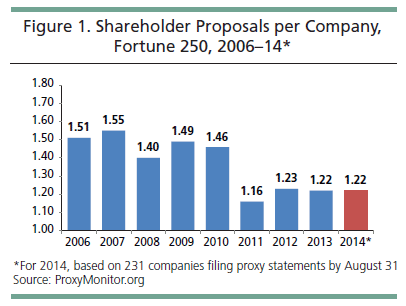 Shareholder-Proposal Incidence
Shareholder-Proposal Incidence
In 2014, the average Fortune 250 company faced 1.22 shareholder proposals on its proxy statement, consistent with 2013 and just below that faced in 2012 (Figure 1). The level of shareholder-proposal activism at America’s largest businesses remains below the level witnessed before 2011: from 2006 through 2010, the average Fortune 250 company faced between 1.40 and 1.55 proposals. The drop in the number of shareholder proposals introduced since 2010 is mostly explained by the 2010 passage of the Dodd-Frank Wall Street Reform and Consumer Protection Act,[25] which required regular shareholder advisory votes on executive compensation beginning in 2011.[26] Ten percent of all shareholder proposals introduced between 2006 and 2010 sought shareholder advisory votes on executive compensation, and such proposals were obviated by the new federal law mandating this change.
Shareholder-Proposal Exclusions and Withdrawals
As we have previously emphasized, the universe of shareholder proposals actually listed on corporate proxy ballots paints an incomplete picture of shareholder-proposal activism.[27] Large companies’ corporate secretaries regularly reach out to the sponsors of shareholder proposals and attempt to reach an understanding with them, such that they withdraw their proposal before proxy ballots are finalized 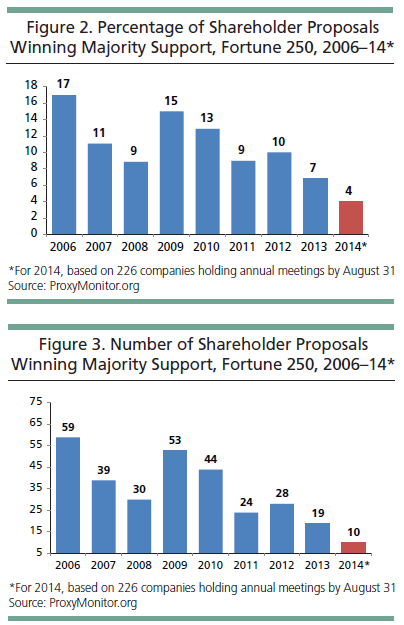 and mailed. In some instances, if the company’s management believes that the proposal does not comply with federal securities regulations, it will petition the Securities and Exchange Commission (SEC) for a “no-action letter” stating that the agency will not recommend enforcement action if the proposal is excluded.[28] Finally, in some cases, companies have resorted to litigation, filing suit asking a federal court to permit it to exclude a ballot item.[29] Although the total number of shareholder proposals introduced but subsequently withdrawn is impossible to know, a 2013 survey of Proxy Monitor companies conducted by the Society of Corporate Secretaries and Governance Professionals[30] suggested that, on average, large companies face 77 percent more shareholder proposals than actually appear on proxy ballots.[31]
and mailed. In some instances, if the company’s management believes that the proposal does not comply with federal securities regulations, it will petition the Securities and Exchange Commission (SEC) for a “no-action letter” stating that the agency will not recommend enforcement action if the proposal is excluded.[28] Finally, in some cases, companies have resorted to litigation, filing suit asking a federal court to permit it to exclude a ballot item.[29] Although the total number of shareholder proposals introduced but subsequently withdrawn is impossible to know, a 2013 survey of Proxy Monitor companies conducted by the Society of Corporate Secretaries and Governance Professionals[30] suggested that, on average, large companies face 77 percent more shareholder proposals than actually appear on proxy ballots.[31]
If the total universe of shareholder proposals is unknowable, it is possible to identify proposals excluded or withdrawn after an SEC no-action petition, since such petitions are public record.[32] In total, in addition to the 284 shareholder proposals listed on Fortune 250 companies’ 2014 proxy ballots filed to date, companies faced another 151 proposals that never made it to the ballot after the company filed a formal no-action request with the SEC. In 116 of these cases, the agency issued a no-action letter, and in another 35, the sponsor of the shareholder proposal withdrew the proposal after the no-action petition was filed. In 50 more cases, the company petitioned the SEC for a no-action letter that the agency denied, determining that the company did not have good cause to exclude the item from the ballot.
In total, Fortune 250 companies have faced at least 435 shareholder proposals in 2014 (1.88 per company having filed) and, undoubtedly, more that were withdrawn absent a formal petition to the SEC. Of these, companies filed an SEC no-action petition 201 times, or 46 percent of the time—a strong indicator of how seriously the companies view the shareholder-proposal process, given the expense of filing a formal agency response.
Shareholder-Proposal Voting: Overview
As noted in the introduction, only 4 percent of shareholder proposals have received the support of a majority of shareholders in 2014, down from 7 percent in 2013—significantly below the percentage of proposals winning majority backing in any previous year in the ProxyMonitor.org database (Figure 2).[33] To date, only ten shareholder proposals have received majority support this year; and only seven over board opposition (Figure 3). The decrease in shareholders’ support for these proposals may have some relationship to stock-market performance, but it is mostly attributable to a change in the mix of proposals being introduced. 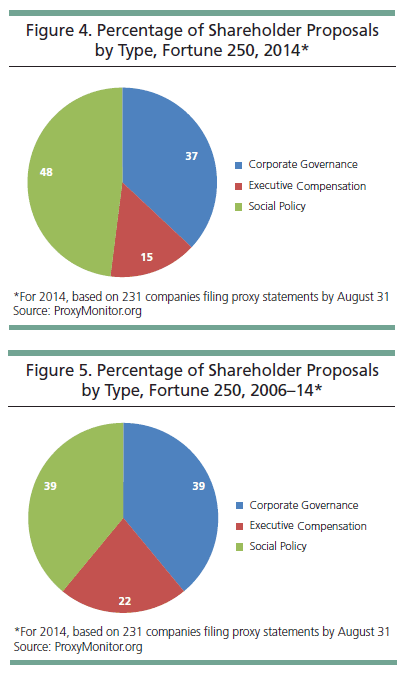 As discussed in more detail in Part II, fewer Fortune 250 firms now face the types of proposals most likely, in years past, to garner majority support: eliminating “staggered” boards in which only a fraction of all directors are elected annually (such boards typically have three slates of directors serving three-year terms); eliminating supermajority voting rules (such as rules requiring more than a majority of shareholders to amend the bylaws or remove a director); and requiring the election of directors by a majority (as opposed to a plurality) of voting shareholders, even in uncontested elections. That such proposals have been less commonly introduced is partly due to these ideas’ broader adoption at many large companies.[34] In addition, companies facing proposals likely to garner majority voting support may have become more likely to negotiate with the shareholder activists proposing them—either by voluntarily adopting the activists’ preferred rules on their own or by taking other actions to persuade the activists to withdraw their proposals.[35]
As discussed in more detail in Part II, fewer Fortune 250 firms now face the types of proposals most likely, in years past, to garner majority support: eliminating “staggered” boards in which only a fraction of all directors are elected annually (such boards typically have three slates of directors serving three-year terms); eliminating supermajority voting rules (such as rules requiring more than a majority of shareholders to amend the bylaws or remove a director); and requiring the election of directors by a majority (as opposed to a plurality) of voting shareholders, even in uncontested elections. That such proposals have been less commonly introduced is partly due to these ideas’ broader adoption at many large companies.[34] In addition, companies facing proposals likely to garner majority voting support may have become more likely to negotiate with the shareholder activists proposing them—either by voluntarily adopting the activists’ preferred rules on their own or by taking other actions to persuade the activists to withdraw their proposals.[35]
II. Subject Matter of 2014 Shareholder Proposals
Social Policy
In 2014, 48 percent of shareholder proposals to make companies’ proxy ballots involved social-policy issues (Figure 4), such as political spending, the environment, or human rights. (Under SEC guidelines, publicly traded companies generally are not required to submit to a vote shareholder proposals relating to “ordinary business practices,”[36] but companies are currently required to let shareholders consider proposals involving “political and moral predilections.”)[37] Such social-investing proposals constituted a much larger portion of shareholder proposals than witnessed historically: for the entire 2006–14 period, only 39 percent of proposals involved social-policy issues (Figure 5).
As in 2012 and 2013, a plurality of all shareholder proposals in 2014 involved corporate political spending or lobbying—22 percent, double the nine-year average (Figures 6 and 7; see also Special Focus: Proposals Related to Political Spending or Lobbying). The share of proposals relating to environmental concerns was also higher (18 percent of 2014 proposals, up from 11 percent over the last nine years). In 2014, shareholders were relatively less likely to sponsor proposals related to animal rights, employment rights, human rights, or other social or policy concerns than they have been in recent years.
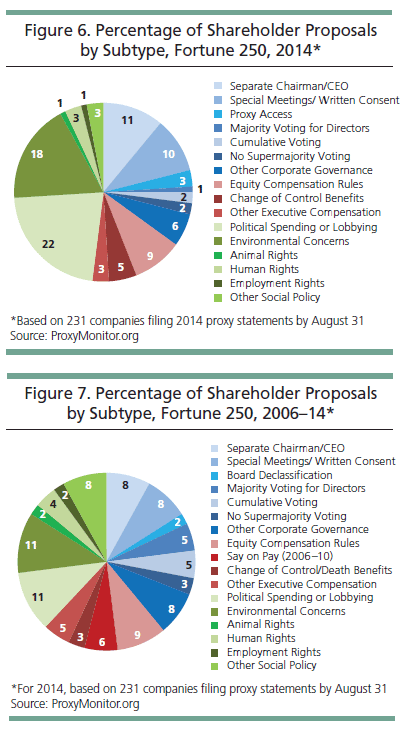 Executive Compensation
Executive Compensation
The percentage of shareholder proposals involving executive compensation, 15 percent, is consistent with the post-Dodd-Frank years but significantly below the nine-year average (22 percent). As previously discussed, 10 percent of shareholder proposals from 2006 through 2010 sought a shareholder advisory vote on executive pay, which fully accounts for the decline in the percentage of shareholder proposals of this type after 2010, when the new Dodd-Frank law made such shareholder advisory votes mandatory. The percentage of 2014 shareholder proposals related to equity compensation plans is consistent with the nine-year average (9 percent), but shareholders introducing executive-compensation-related proposals this year were more likely to focus on change-of-control benefits (called “golden parachutes” by detractors) than in other years.
Corporate Governance
The percentage of shareholder proposals related to corporate-governance issues is down marginally in 2014, to 37 percent, as compared with a nine-year average of 39 percent. In part, this drop is due to fewer proposals on the ballot among those classes of proposals most likely to attract majority shareholder support—board declassification, majority voting for director, and eliminating supermajority voting provisions—as discussed in Part I. In 2014, no Fortune 250 company faced a board-declassification proposal on its ballot, only 1 percent of all proposals involved majority voting for directors, and only 2 percent involved mandating simple majority voting on all matters. Other types of corporate-governance proposals, however, were more commonplace, including those seeking to separate the company’s chairman and CEO positions (11 percent of all 2014 proposals, up from 8 percent over the full 2006–14 period); those seeking to increase shareholders’ powers to act outside annual meetings, by written consent or by calling special meetings (10 percent, up from 8 percent); and those seeking to empower shareholders, under certain conditions, to have the ability to nominate their own preferred directors, to be listed on corporate proxy ballots (3 percent). (Beginning in 2012, shareholders were permitted to place such “proxy access” proposals on the ballot, after the mandatory proxy-access rule previously instituted by the SEC was struck down as “arbitrary and capricious” by the U.S. Court of Appeals for the D.C. Circuit in July 2011.)[38]
Voting Results by Proposal Type
Among the ten shareholder proposals to receive majority shareholder support among Fortune 250 companies to date in 2014, seven involved corporate governance questions; two involved executive compensation; and one involved social or policy concerns (Table 1). The corporate-governance proposals to pass included:
- Three proposals seeking to end supermajority-voting requirements in company bylaws (of six introduced and coming to a vote)
- Two proposals seeking to permit shareholders to call special meetings (of eight introduced and coming to a vote)
- One proposal seeking to separate the company’s chairman and CEO positions (of 32 introduced and coming to a vote)
- An anti-poison-pill provision, introduced by billionaire activist investor Mario Gabelli’s GAMCO fund at Navistar (which, without board opposition, won 92 percent shareholder support)
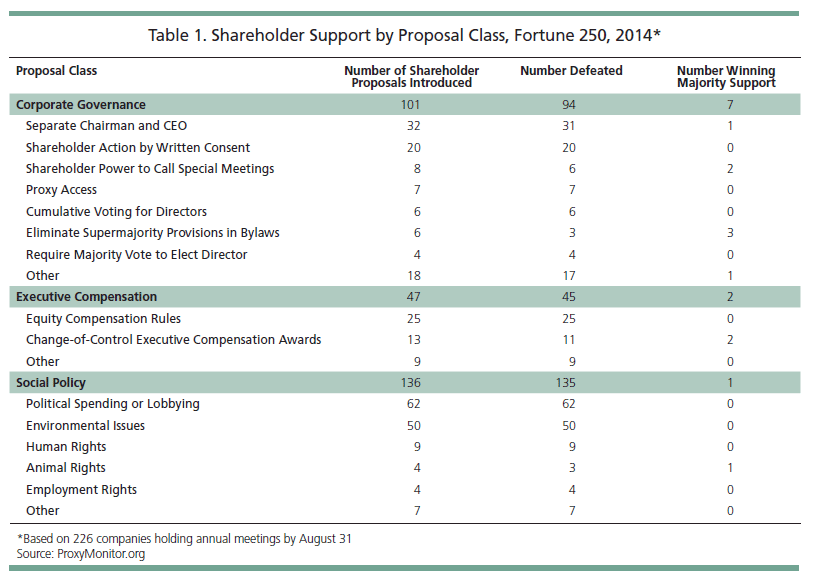
The two executive-compensation-related proposals to win majority shareholder support each sought to ensure that there would be no accelerated vesting of the company’s performance-based equity-compensation awards in the event of a change of control (two of 13 golden-parachute-related proposals introduced and coming to a vote). One was introduced by the Philadelphia Public Employee Retirement System at Dean Foods and the other by the labor-affiliated Amalgamated Bank at Valero Energy: these proposals received the support of 60 and 56 percent of shareholders, respectively.
The social-policy proposal to win majority shareholder support was a “laudatory resolution” in support of animal-welfare standards introduced by the Humane Society at Kraft Foods, calling on the company to work toward higher animal-welfare standards in its pork supply chain. The board supported the proposal, which received the support of 76 percent of voting shareholders.
Notably absent from the types of proposals receiving majority support in 2014—in addition to proposals seeking to declassify the board of directors, none of which were introduced—were proposals seeking shareholder authority to act by written consent, those seeking to require directors to receive a majority of votes cast in uncontested elections, and those seeking to give shareholders the power to place their own director nominees on the corporation’s proxy (proxy access). Each of these proposal types received significant shareholder support in earlier years.[39]
Special Focus: Proposals Related to Political Spending or Lobbying
Since the Supreme Court’s 2010 decision in Citizens United v. Federal Election Commission,[40] which determined that independent political expenditures were speech protected by the First Amendment to the United States Constitution, even as applied to corporations, Fortune 250 companies have faced a significantly increased number of shareholder proposals related to their political spending or lobbying decisions. The number of such proposals introduced at Fortune 250 companies hovered between 19 and 23 annually from 2006 through 2009, but that number jumped to 44 in 2011, the first full year after Citizens United, and has continued to increase thereafter (Figure 8). In each of the last three years, proposals related to corporate political spending or lobbying have been more numerous than any other class of proposal.
As in previous years, shareholder proposals related to a company’s political spending or lobbying failed to gain substantial traction in 2014. In each of the last nine years, between 75 and 83 percent of shareholders have voted against such proposals, on average (Figure 9). If one looks solely at the narrower class of political-spending-disclosure proposals of the sort advocated by the Center for Political Accountability (CPA),[41] an organization headed by former Democratic congressional staffer Bruce Freed that is solely focused on this topic, there is only modestly more shareholder support: over the full nine-year period, between 72 and 80 percent of shareholders have opposed CPA’s proposal each year, on average, across the Fortune 250—with 74 percent of shareholders doing so in 2014. In no instance over the full nine-year period covered by Proxy Monitor has a shareholder proposal related to corporate political spending or lobbying received the support of a majority of shareholders over board opposition.[42]
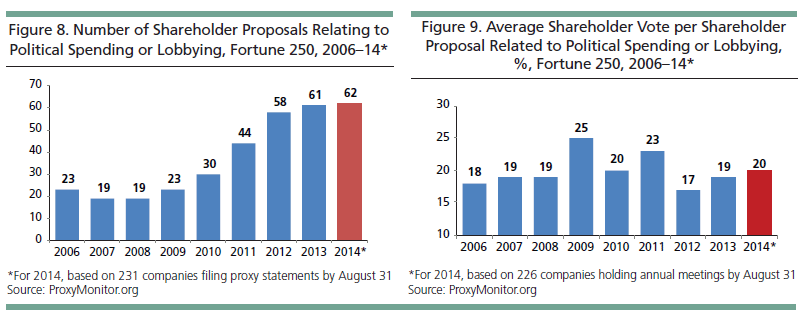
|
Written Consent. Shareholder proposals seeking shareholder power to act through written consent first showed up in 2010, when a group of individual “gadfly” investors sponsored 14 on Fortune 250 companies’ proxy ballots. In that first year, ten of 14 proposals were supported by shareholders, though they subsequently fared much worse:
- Eight of 24 received majority support in 2011
- Two of 16 in 2012
- One of 18 in 2013
- Zero of 20 in 2014
Clearly, although shareholders were initially favorably disposed to the concept of shareholder action by written consent, at least some have become more skeptical over time.
Majority Voting for Directors. Requiring directors to receive a majority of votes cast in uncontested director elections—which empowers dissident shareholders who want to launch “withhold” campaigns against certain director nominees without launching a formal proxy fight—is another type of proposal that has seen support wane in recent years. These proposals, typically backed by the United Brotherhood of Carpenters and other labor-affiliated pension funds, were among those most commonly introduced, and most supported, in 2006 (the first year in the Proxy Monitor database), when 57 majority-voting proposals were introduced and 23 received majority backing from shareholders. In 2007, six of 17 such proposals received majority support, and from 2008 through 2012, between nine and 12 were sponsored annually, with between 27 and 45 percent of such proposals winning shareholder majorities. Only one of six such proposals received majority support in 2013, however, and none of the four proposals of this type introduced to date in 2014 has won the support of 50 percent of shareholders.
Proxy Access. After one of three shareholder proposals seeking proxy access for shareholders’ director nominees won the support of shareholder majorities in 2012—the first year after the D.C. Circuit overturned a mandatory-access rule promulgated by the SEC[43]—there was some thought that such proposals might become commonplace, so they warranted careful observation.[44] Two of seven proxy access proposals received majority support in 2013, and none of seven introduced have won majority support so far this year. In 2014, as in earlier years, shareholders’ reaction to these proposals varies according to their specifics. A proposal by the “Change to Win” public-employee-union pension fund at Walgreens—which tracked the former SEC rule and required a nominating shareholder to have owned at least 3 percent of the company’s shares for at least three years to gain proxy access—received the support of 43 percent of shareholders. Other shareholder proposals by individual investors James McRitchie and John Harrington, which called for lower ownership thresholds and holding periods (two years and 1 percent), received the support of only 3 to 7 percent of shareholders.
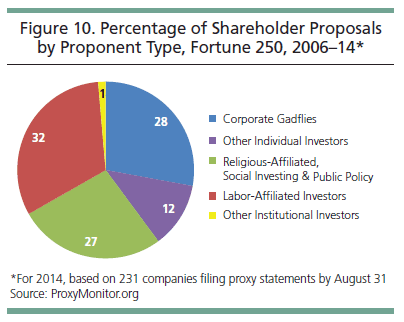 III. Sponsors of 2014 Shareholder Proposals
III. Sponsors of 2014 Shareholder Proposals
In 2014, as has been the case in each of the nine years included in the ProxyMonitor.org data base, a small group of shareholders has dominated the process of introducing shareholder proposals. These shareholder-proposal activists break down into three rough groupings:
1. Labor-Affiliated Investors. Pension funds managing retirement assets for employees are among the largest investors in the marketplace and have, historically, been among the most active sponsors of shareholder proposals at publicly traded corporations. (Such funds can be organized for the employees of specific companies or as “multiemployer” plans affiliated with labor unions, such as AFL-CIO or AFSCME, or can exist as creatures of states and municipalities on behalf of public-sector workers.) These labor-affiliated investors have sponsored 32 percent of all shareholder proposals introduced to the Fortune 250 between 2006 and 2014 (Figure 10), and 24 percent of all proposals introduced in 2014. As explained in an earlier Proxy Monitor finding,[45] the drop in labor-affiliated shareholder activism in 2014 has been concentrated among private multiemployer plans, which have seen half the level of activity witnessed last year (Figures 11 and 12).
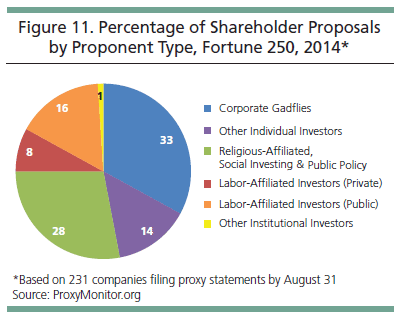 |
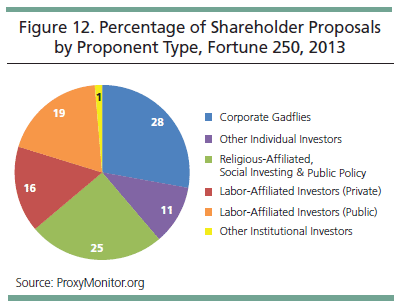 |
2. Corporate Gadflies. These individual investors have relatively modest investment holdings in many large companies and file multiple shareholder proposals, substantially similar in type, across many companies, year after year. From 2006 through 2014, just five individuals and their family members—John Chevedden (and his late father, Ray), William Steiner (and his son Kenneth), James McRitchie (and his wife, Myra K. Young), Emil Rossi (and his sons and other relatives), and Evelyn Davis—have sponsored 28 percent of all shareholder proposals introduced at Fortune 250 companies. In 2014, just three of these gadflies—Chevedden, Steiner, and McRitchie (octogenarians Rossi and Davis are essentially “retired” from shareholder activism)—have sponsored one-third of all shareholder proposals.
3. Social Investors. Many institutional investors with an express orientation toward “socially responsible” investing,[46] as well as various retirement and investment vehicles associated with religious or public-policy organizations,[47] introduce multiple shareholder proposals designed to influence companies to alter their behavior in keeping with those organizations’ goals. Such investors have sponsored 28 percent of all shareholder proposals in 2014, and 27 percent across the full 2006–14 period.
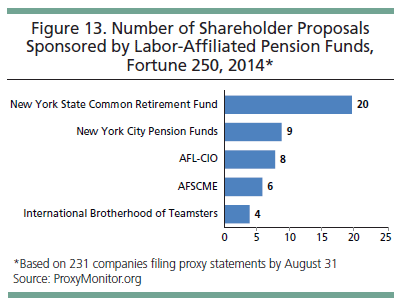 Individual investors other than the major corporate gadflies have sponsored 14 percent of shareholder proposals in 2014 and 12 percent in the 2006–14 period. Institutional investors unaffiliated with labor unions, or state and municipal workers, and lacking a religious, social-investing, or public-policy orientation, have sponsored only 1 percent of shareholder proposals, both in 2014 and the broader nine-year period.
Individual investors other than the major corporate gadflies have sponsored 14 percent of shareholder proposals in 2014 and 12 percent in the 2006–14 period. Institutional investors unaffiliated with labor unions, or state and municipal workers, and lacking a religious, social-investing, or public-policy orientation, have sponsored only 1 percent of shareholder proposals, both in 2014 and the broader nine-year period.
Labor-Affiliated Investors
As already noted, labor-affiliated pension funds played a less active role in shareholder-proposal activism in 2014 than in earlier years, caused chiefly by a decline in activism on the part of private multiemployer plans. The most active labor-affiliated activist in 2014 was the New York State Common Retirement Fund, which sponsored 20 shareholder proposals, followed by the pension funds for New York City employees, AFL-CIO, and AFSCME—which have respectively introduced nine, eight, and six shareholder proposals at Fortune 250 companies in 2014 (Figure 13). (For more detail on these funds’ activism, see Appendix A.)
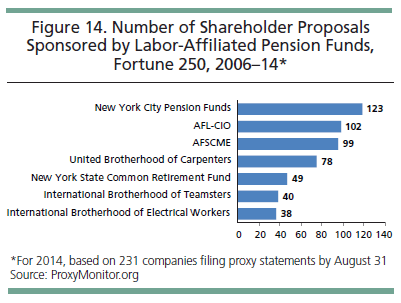 With state and municipal funds, led by the New York State and City funds, playing relatively more prominent roles in labor-affiliated shareholder-proposal activism in 2014 (compare Figure 13 with Figure 14), shareholder proposals sponsored by this class of investor have been more oriented toward social and policy concerns than the historical norm. Some 65 percent of all labor-affiliated shareholder proposals introduced at Fortune 250 companies in 2014 have involved social or policy concerns, as opposed to just 32 percent in the 2006–14 period (compare Figure 15 with Figure 16). Only 15 percent of 2014 labor-backed shareholder proposals have involved traditional corporate governance issues, and just 20 percent have involved executive compensation; each of these classes of shareholder proposal has constituted 34 percent of labor-affiliated proposals in the broader 2006–14 period. The only two shareholder proposals sponsored by labor-affiliated investors to receive majority shareholder support in 2014 were executive-compensation-related, involving change-in-control equity compensation awards.
With state and municipal funds, led by the New York State and City funds, playing relatively more prominent roles in labor-affiliated shareholder-proposal activism in 2014 (compare Figure 13 with Figure 14), shareholder proposals sponsored by this class of investor have been more oriented toward social and policy concerns than the historical norm. Some 65 percent of all labor-affiliated shareholder proposals introduced at Fortune 250 companies in 2014 have involved social or policy concerns, as opposed to just 32 percent in the 2006–14 period (compare Figure 15 with Figure 16). Only 15 percent of 2014 labor-backed shareholder proposals have involved traditional corporate governance issues, and just 20 percent have involved executive compensation; each of these classes of shareholder proposal has constituted 34 percent of labor-affiliated proposals in the broader 2006–14 period. The only two shareholder proposals sponsored by labor-affiliated investors to receive majority shareholder support in 2014 were executive-compensation-related, involving change-in-control equity compensation awards.
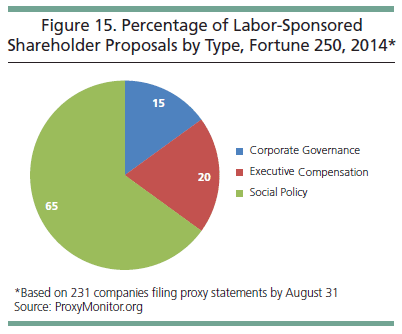 |
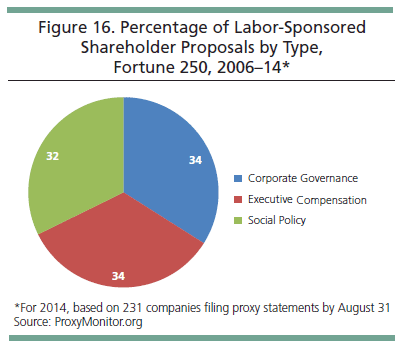 |
Special Focus: Labor-Affiliated Activism and Corporate Politics
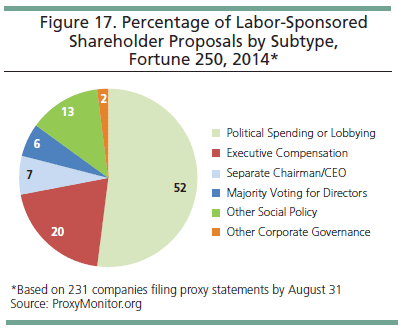 Fully 52 percent of all shareholder proposals sponsored by labor-affiliated investors in 2014 have related to corporate political spending or lobbying (Figure 17), and labor-affiliated investors have sponsored 51 percent of all such proposals introduced at Fortune 250 companies this year. In our 2013 Proxy Monitor report, we observed that “the focus of labor-affiliated pension funds’ shareholder-proposal activism…broadly supports the hypothesis that at least some of these funds’ efforts in this area may have a political purpose,” given that, last year, “corporations that gave at least half of their donations to support Republicans were more than twice as likely to be targeted by shareholder proposals sponsored by labor-affiliated funds as those companies that gave a majority of their politics-related contributions on behalf of Democrats.”[48] Fully 52 percent of all shareholder proposals sponsored by labor-affiliated investors in 2014 have related to corporate political spending or lobbying (Figure 17), and labor-affiliated investors have sponsored 51 percent of all such proposals introduced at Fortune 250 companies this year. In our 2013 Proxy Monitor report, we observed that “the focus of labor-affiliated pension funds’ shareholder-proposal activism…broadly supports the hypothesis that at least some of these funds’ efforts in this area may have a political purpose,” given that, last year, “corporations that gave at least half of their donations to support Republicans were more than twice as likely to be targeted by shareholder proposals sponsored by labor-affiliated funds as those companies that gave a majority of their politics-related contributions on behalf of Democrats.”[48]
These observations also hold true in 2014. Among the 43 Fortune 250 companies facing 2014 shareholder proposals sponsored by labor-affiliated investors, the executives and political action committees of only five contributed more money to Democrats than to Republicans in the prior political cycle (just under 12 percent, as opposed to almost 25 percent of all companies in the Fortune 250); and only one of these five companies faced a labor-sponsored shareholder proposal related to political spending or lobbying (Newmont Mining Corporation, which faced a political-spending-disclosure shareholder proposal introduced by the New York State Common Retirement Fund and which gave 65 percent of its political contributions to support Democrats).[49] Companies facing at least one labor-affiliated shareholder proposal related to corporate political spending or lobbying spent, on average, more money on politics—and sent, on average, 67 percent of their dollars to support the GOP, versus 59 percent for all companies in the Fortune 250 (Figures 18 and 19).
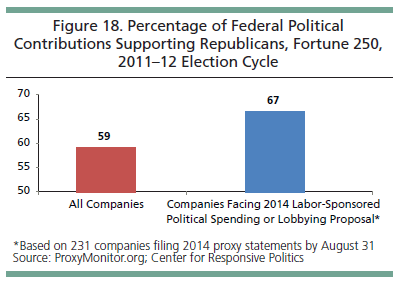 |
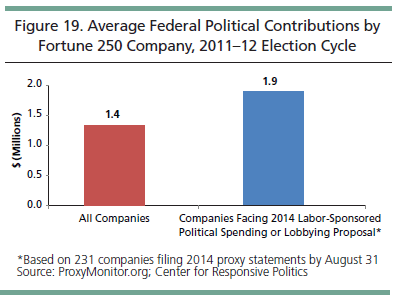 |
|
Corporate Gadflies
Since 2006, John Chevedden, William Steiner, and Evelyn Davis (and their respective family members) have sponsored 232, 215, and 153 proposals, respectively, at Fortune 250 companies (Figure 20). Over this period, these individuals and four others (and respective family members) have sponsored 787 shareholder proposals listed on the ballots of Fortune 250 companies; no other individual investor has sponsored more than ten.
Chevedden, William and Kenneth Steiner, and the husband-wife team of James McRitchie and Myra Young have sponsored 70 percent of all shareholder proposals introduced by individuals in 2014 (Figure 21); these and other prominent corporate gadflies have sponsored about the same percentage over the 2006–14 period (Figure 22).
Although there are exceptions, such as the idiosyncratic Davis and social investor John Harrington, corporate gadflies tend to focus their proposals on procedural corporate governance rules (for a more detailed discussion of leading gadflies’ activism, see Appendix A). They have, moreover, generally had significant success in sponsoring at least some proposals that a majority of shareholders might back. Over the 2006–14 period, 29 percent of shareholder proposals introduced by the Steiners won the support of a majority of shareholders, 19 percent of those introduced by Chevedden, and 18 percent of those introduced by McRitchie and Young. In 2014, each was significantly less successful (Figure 23).
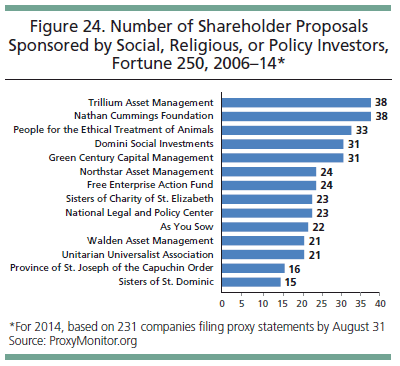 Social Investors
Social Investors
Shareholder-proposal activism among socially responsible investors is spread among a broader group of shareholders than that by labor-affiliated investors and corporate gadflies. The two most active socially oriented investors, Trillium Asset Management[50] and the Nathan Cummings Foundation,51 each sponsored just 38 shareholder proposals across the entire 2006–14 period (Figure 24)—only 16 percent as many as John Chevedden. Twelve others, however, each sponsored between 15 and 33 shareholder proposals: social-investing funds Domini Social Investments, Green Century Capital Management, Northstar Asset Management, As You Sow, and Walden Asset Management; policy-oriented People for the Ethical Treatment of Animals (PETA), Free Enterprise Action Fund, and National Legal and Policy Center; and religious entities Sisters of Charity of St. Elizabeth, Unitarian Universalist Association of Congregations, Province of St. Joseph of the Capuchin Order, and Sisters of St. Dominic.
Over the entire 2006–14 period, religious-oriented investors sponsored 39 percent of all shareholder proposals introduced by those investors with a social or policy orientation and social-investing funds, 36 percent. Yet so far this year, social-investing funds have sponsored 51 percent of proposals sponsored by this investor class (Figures 25 and 26). (For more on this trend, see Appendix A.)
The vast majority of shareholder proposals sponsored by this group of investors, predictably, has involved social or policy concerns—including 95 percent of all proposals introduced in 2014 and 82 percent of all proposals introduced across the entire 2006–14 period. In 2014, 43 percent of all proposals introduced by this investor class have involved environmental issues, while one-third have involved corporate political spending and lobbying (Figure 27).
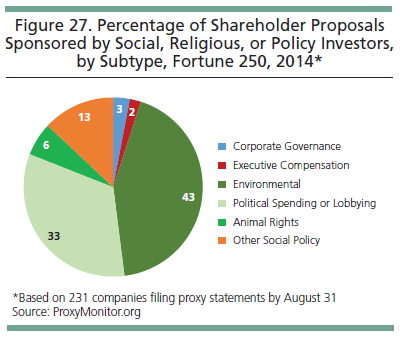 With such a focus on social and policy concerns, this investor class has, unsurprisingly, enjoyed limited success introducing proposals supported by a majority of fellow shareholders. In 2014, the Humane Society’s proposal introduced at Kraft calling on the company to issue a “laudatory resolution in support of animal welfare” was the only proposal introduced by this investor class to win the support of a majority of shareholders—and only after the company’s board of directors endorsed the proposal. Indeed, all 537 shareholder proposals with a social or policy orientation that social-investing-oriented investors sponsored at Fortune 250 companies from 2006 through 2014 (and indeed, all 1,141 such proposals overall) failed to attract the support of a majority of shareholders over board opposition.[52] Over that period, only 12 shareholder proposals introduced by this class of investors won majority support from shareholders over board opposition, with each involving classic corporate governance or executive-compensation concerns: four board-declassification proposals; six say-on-pay proposals; and a pair of 2008 proposals introduced by the Children’s Investment Fund at CSX seeking to overturn CSX’s bylaw amendments and give shareholders additional powers to call special meetings.
With such a focus on social and policy concerns, this investor class has, unsurprisingly, enjoyed limited success introducing proposals supported by a majority of fellow shareholders. In 2014, the Humane Society’s proposal introduced at Kraft calling on the company to issue a “laudatory resolution in support of animal welfare” was the only proposal introduced by this investor class to win the support of a majority of shareholders—and only after the company’s board of directors endorsed the proposal. Indeed, all 537 shareholder proposals with a social or policy orientation that social-investing-oriented investors sponsored at Fortune 250 companies from 2006 through 2014 (and indeed, all 1,141 such proposals overall) failed to attract the support of a majority of shareholders over board opposition.[52] Over that period, only 12 shareholder proposals introduced by this class of investors won majority support from shareholders over board opposition, with each involving classic corporate governance or executive-compensation concerns: four board-declassification proposals; six say-on-pay proposals; and a pair of 2008 proposals introduced by the Children’s Investment Fund at CSX seeking to overturn CSX’s bylaw amendments and give shareholders additional powers to call special meetings.
IV. Proxy Advisors and Institutional Shareholder Services
On June 30, the SEC issued new rules clarifying the duties of proxy advisory firms[53]—private entities that both issue guidance to institutional investors on how to vote on proxy matters, including shareholder proposals, and help institutional investors execute their votes. The SEC’s new rules followed in the wake of a December 5, 2013, roundtable discussion[54] on the topic that the commission hosted, along with a June 5, 2013, hearing, “Examining the Market Power and Impact of Proxy Advisory Firms,” before the Capital Markets and Government Sponsored Enterprises Subcommittee of the Committee on Financial Services of the U.S. House of Representatives.[55] The SEC’s new rules raise the bar for proxy advisors, clarifying that advisors have duties of accuracy and disclosure, as well as specifying the rights and obligations of issuing corporations and institutional investors that may use such firms as clients.
The importance of proxy advisory firms traces significantly to a 1988 decision by the U.S. Department of Labor imposing fiduciary obligations on the shareholder votes of retirement benefit funds governed by ERISA.[56] In 2003, the SEC clarified that similar fiduciary duties attach to mutual funds and other registered investment companies.[57] The New York Stock Exchange rules that limited stockbrokers’ ability to vote the shares of their individual investors increased the influence of institutional investors using proxy advisors as clients,[58] and mandatory shareholder advisory voting on executive compensation in the Dodd-Frank law[59] increased the complexity of proxy voting matters—on top of the 20,000 proxy items already existing for Russell 3000 companies.[60]
The largest proxy advisory firm, Institutional Shareholder Services, or ISS,[61] was well positioned to take advantage of these changes after it was incorporated in 1985.[62] Today the firm has an estimated 61 percent market share.[63] On April 30, 2014, ISS was sold to private-equity firm Vestal Capital Partners from the publicly traded MSCI,[64] which had previously acquired the business along with ISS’s former parent company, RiskMetrics, in 2010.[65] ISS’s only large competitor is Glass, Lewis & Co., a subsidiary of the Ontario Teachers’ Pension Plan Board.[66]
By its own estimation, ISS helps more than 1,700 clients execute nearly 7 million ballots representing 2.7 trillion shares.[67] The company ’s market power is vast: a 2012 analysis by the Manhattan Institute, including two of this report ’s coauthors, found that an ISS recommendation “For” a given shareholder proposal—controlling for other factors including company size, proponent type, proposal type, and year—was associated with a 15-percentage-point increase in the shareholder vote for any given proposal.[68] Thus, in the shareholder-proposal context, ISS acts like a 15-percent owner of the largest publicly traded companies in the market. As Leo Strine, a former chancellor on the Delaware Court of Chancery, observed: “Powerful CEOs come on bended knee to Rockville, Maryland, where ISS resides, to persuade the managers of ISS of the merits of their views about issues.”[69]
Notwithstanding its influence, ISS is a relatively small operation: it has fewer than 700 employees[70] and just over $15 million in profits on $122 million in revenues.[71] A significant fraction of those revenues comes not from sales to the institutional-investment community itself but rather from the company’s “Corporate Sales” division, which offers governance and proxy advice to corporations—in essence, the very companies on whose proxies ISS advises institutional investors on how to vote. In 2013, ISS’s Corporate Sales group generated 29.2 percent of its revenues, up from 21.2 percent two years earlier.[72]
The probable reason for the disconnect between ISS’s cash flows and influence is that institutional investors simply do not place significant economic value on the services it offers. In almost all situations, there is little competitive advantage to be gained from being a “better voter” on proxy items, at least those proposed by shareholders through the 14a-8 process.[73] Large institutional investors, like Fidelity or Vanguard, with sufficient resources to make their own proxy voting decisions and not lose appreciable cost advantage to competitors surely find ISS’s analytical tools useful; smaller funds wanting to minimize their investment in voting find hiring ISS a useful way to discharge fiduciary voting obligations at low cost. But the very fact that the cost is low—less than $80 million in annual revenues[74] in the context of $26 trillion in assets—shows that ISS’s services are not that highly valued by institutional investors, which also helps explain the lack of significant competitors and dearth of new entrants into the proxy advisory space.
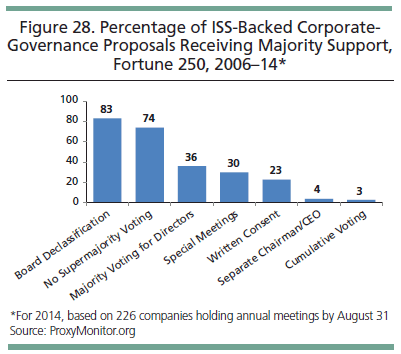 Such forces enable ISS to support ballot items that are generally rejected by most investors, without fear of reprisal. Our previous research shows that ISS has, historically, been almost eight times as likely as the median shareholder to support a shareholder proposal.[75] ISS’s current policy guidelines continue to reflect this disconnect. Among the class of most-introduced shareholder proposals involving corporate governance issues that ISS is “generally for,”[76] shareholder reaction varies significantly: proposals to declassify boards of directors and eliminate supermajority proposals are more likely than not to pass; those calling for majority votes to elect directors, or for shareholder power to call special meetings, or act through written consent, gain occasional support; and those calling for separating the company’s chairman and CEO roles, or enabling cumulative voting for director nominees, almost always fail (Figure 28).[77] MSCI, which was still the parent company for ISS when it issued its 2014 guidelines, has a joint chairman and CEO and states emphatically on its webpage: “The Board strongly supports the one share/one vote concept and opposes cumulating voting. It opposes the ability of a single investor or group of investors to band together to achieve a goal, such as the election of a director, which is not supported by a majority of the Company’s shareholders.”[78]
Such forces enable ISS to support ballot items that are generally rejected by most investors, without fear of reprisal. Our previous research shows that ISS has, historically, been almost eight times as likely as the median shareholder to support a shareholder proposal.[75] ISS’s current policy guidelines continue to reflect this disconnect. Among the class of most-introduced shareholder proposals involving corporate governance issues that ISS is “generally for,”[76] shareholder reaction varies significantly: proposals to declassify boards of directors and eliminate supermajority proposals are more likely than not to pass; those calling for majority votes to elect directors, or for shareholder power to call special meetings, or act through written consent, gain occasional support; and those calling for separating the company’s chairman and CEO roles, or enabling cumulative voting for director nominees, almost always fail (Figure 28).[77] MSCI, which was still the parent company for ISS when it issued its 2014 guidelines, has a joint chairman and CEO and states emphatically on its webpage: “The Board strongly supports the one share/one vote concept and opposes cumulating voting. It opposes the ability of a single investor or group of investors to band together to achieve a goal, such as the election of a director, which is not supported by a majority of the Company’s shareholders.”[78]
Beyond corporate-governance proposals, the disconnect between ISS and the median shareholder is even starker. Our previous research reveals that ISS supported shareholder proposals related to a company’s equity compensation plan 75 percent of the time;[79] but only two of 249 such proposals introduced at Fortune 250 companies from 2006 through 2014 have received the support of a majority of shareholders. Among shareholder proposals involving social or policy concerns, not a single proposal at a Fortune 250 company received support from a majority of shareholders, over board opposition, over the last nine years. In contrast, ISS is “generally for” certain classes of animal rights, employment rights, human rights, environmental, and political-spending-related shareholder proposals; against others; and decides others on a “case by case” basis.[80] Historically, ISS has backed some 70 percent of shareholder proposals related to political spending, 45 percent of those related to employment rights, and 35 percent of those related to human rights or the environment[81]—a sharp contrast to the dearth of average shareholder support for these proposal classes.
Although the gap between ISS recommendations and the median shareholder could be explained by simple disagreement, it is worth noting that an increase in shareholder voting support for various proposals also increases the incentive for public companies to enter into consulting contracts with ISS to mitigate such costs. In addition, the absence of market constraints on ISS means that it may be subject to capture by some of its clients who do place more emphasis on shareholder ballot items than do other institutional investors and most individual investors—namely, labor-pension funds and social-investing funds, each of which are very active in sponsoring proposals. Even if ISS support is generally unlikely to tip the balance of shareholder support in favor of a given proposal—and the evidence suggests that it is not, at least for social and policy proposals—the 15-percentage-point bump that an ISS “For” recommendation tends to generate will ensure that with ISS support, shareholder-proposal activists’ preferred issues remain on the proxy ballot as long as their proponents wish them to remain there, under current SEC resubmission standards.
With new SEC guidance for proxy advisory firms and a new ownership team for ISS, the firm’s approach could be altered significantly, going forward. Time will tell the impact of the regulatory and ownership changes.
Conclusion
It has been an eventful year in the world of corporate governance and shareholder-proposal activism. In December 2013, SEC chairman Mary Jo White announced that the agency would not, for the time being, engage in rulemaking on corporate political spending disclosure—following the revealed preferences of shareholders that have universally failed to pass shareholder proposals on this topic.[82] In April 2014, the commission received a rulemaking petition from business trade associations that could prompt the agency to look at shareholder-proposal resubmission thresholds—which could, were the SEC to act in this area, significantly affect shareholder-proposal activism as we know it.[83] Finally, in June 2014, the SEC issued long-awaited rules governing proxy advisory firms, the effects of which will be interesting to observe.[84]
Outside the regulatory arena, the story of 2014 has largely been one of significantly less success on the part of shareholder-proposal activists. Although as active as ever in introducing shareholder proposals, these activists have had a much more difficult time persuading fellow shareholders to follow: apart from proposals unopposed by boards of directors, only seven shareholder proposals were supported by a majority of shareholders, across the entire Fortune 250. This trend suggests that companies are doing a better job of communicating with their investors, or that shareholders are increasingly viewing the shareholder-proposals activists’ goals as inconsistent with their own interests.
The shareholder voting results in the 2014 proxy season, and those of the broader 2006–14 period, should inform further policy considerations:
- The dearth of support for shareholder proposals related to corporate political spending or lobbying—with none of the 329 shareholder proposals introduced at Fortune 250 companies over the last nine years receiving support from a majority of shareholders over board opposition—should continue to counsel the SEC not to engage in rulemaking on this subject.[85]
- The complete absence of support for any shareholder proposal related to social or policy concerns more broadly—with none of the 1,141 social- or policy-related shareholder proposals introduced at Fortune 250 companies over the last nine years receiving majority shareholder support over board opposition—should, in an appropriate case, give the D.C. Circuit reason to reconsider its stand about the appropriateness of such proposals under securities law.[86]
- The ability of a single proxy advisory firm, ISS, to vault shareholder proposals above the SEC’s current resubmission threshold—enabling socially oriented, or small, investors to place proposal ideas on shareholder ballots ad infinitum—should counsel the commission to maintain its vigilance in implementing its new proxy advisory guidance, while prompting the commission to engage in proposed rulemaking concerning resubmission thresholds (as well as, perhaps, to increase minimum shareholder holdings to introduce 14a-8 proxy ballot proposals).
Time will tell whether the 2014 trend of reduced success among shareholder activists continues—and whether lawmakers, judges, and regulators pay attention to these trends in crafting and interpreting laws and regulations going forward.
APPENDIX A:
Shareholder-Proposal Sponsorship
This appendix offers more detail about the shareholder-proposal activism of investors in each of the three major categories—labor-affiliated investors, corporate gadflies, and social investors—both in 2014 and the broader 2006–14 period. Special focus is given to:
- The New York City and State pensions, which have led all labor-affiliated investors in sponsoring shareholder proposals across both the broader period and this year
- John Chevedden, William and Kenneth Steiner, and James McRitchie and Myra Young, who together have sponsored 70 percent of all individual-investor-sponsored shareholder proposals in 2014
- The trend in social investors’ shareholder activism away from religious institutions’ pension funds and toward social-investing funds
The appendix concludes with a brief assessment of coordination among leading shareholder activists, across and within groups.
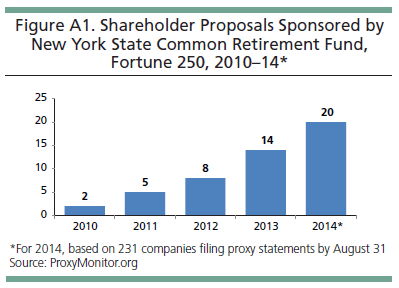 Labor-Affiliated Investors
Labor-Affiliated Investors
New York State Common Retirement Fund. The New York State Common Retirement Fund holds assets in trust for the New York State & Local Retirement System (NYSLRS).[87] The state’s publicly elected comptroller,[88] currently Democrat Thomas P. DiNapoli, is the fund’s sole trustee.[89] The New York State fund has introduced 20 shareholder proposals in 2014, more than any other investor save Chevedden and Steiner. After introducing no shareholder proposals at Fortune 250 companies between 2006 and 2009, the New York State fund introduced two in 2010 and has subsequently increased its shareholder activism to assume a leading role (Figure A1). Fourteen of the 20 shareholder proposals introduced by the New York State fund in 2014 involved corporate political spending or lobbying, four involved environmental issues, one involved employment rights, and one involved executive compensation.
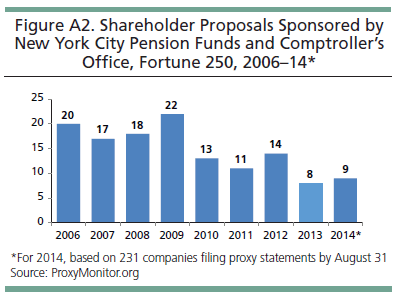 New York City Pension Funds. The five pension funds managing assets for New York City employees have a history of shareholder activism, particularly that with a social bent—dating long before the 2013 election of City Comptroller Scott Stringer,[90] under whose brief tenure the funds’ activism has been somewhat more restrained (Figure A2). (In contrast to the New York State fund, full fiduciary authority for the five New York funds rests with boards of trustees composed of political officials and union delegates.)[91] The New York City pension funds and comptroller’s office have been the most active sponsors of shareholder proposals among all institutional investors over the 2006–14 period covered in the Proxy Monitor database. Five of the New York City funds’ nine proposals in 2014 related to social or policy issues (four on political spending and one on race and gender employment reporting); two to executive compensation; and two to corporate governance (seeking to split the chairman and CEO roles). Historically, 75 percent of the NYC pension’s shareholder proposals have involved social or political issues.
New York City Pension Funds. The five pension funds managing assets for New York City employees have a history of shareholder activism, particularly that with a social bent—dating long before the 2013 election of City Comptroller Scott Stringer,[90] under whose brief tenure the funds’ activism has been somewhat more restrained (Figure A2). (In contrast to the New York State fund, full fiduciary authority for the five New York funds rests with boards of trustees composed of political officials and union delegates.)[91] The New York City pension funds and comptroller’s office have been the most active sponsors of shareholder proposals among all institutional investors over the 2006–14 period covered in the Proxy Monitor database. Five of the New York City funds’ nine proposals in 2014 related to social or policy issues (four on political spending and one on race and gender employment reporting); two to executive compensation; and two to corporate governance (seeking to split the chairman and CEO roles). Historically, 75 percent of the NYC pension’s shareholder proposals have involved social or political issues.
Corporate Gadflies
Although corporate gadflies, as a whole, have maintained a significant role in shareholder-proposal activism throughout the 2006–14 period—John Chevedden, 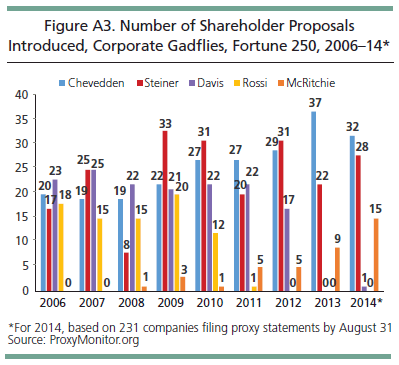 as well as the father-son team of William and Kenneth Steiner, have consistently been among the most active shareholders sponsoring proposals throughout this period—various other gadflies have come and gone (Figure A3). Evelyn Davis and Emil Rossi, now both well into their eighties, have fully (or almost fully) ceased shareholder-proposal activism. Taking their place as a leading corporate gadfly is James McRitchie.
as well as the father-son team of William and Kenneth Steiner, have consistently been among the most active shareholders sponsoring proposals throughout this period—various other gadflies have come and gone (Figure A3). Evelyn Davis and Emil Rossi, now both well into their eighties, have fully (or almost fully) ceased shareholder-proposal activism. Taking their place as a leading corporate gadfly is James McRitchie.
John Chevedden, now 68, introduced his first shareholder proposal in 1994 at General Motors. Three years earlier, Chevedden had been laid off from the company’s subsidiary, Hughes Aircraft,[92] and, before filing his proposal, he lodged a discrimination complaint against Hughes with the Equal Employment Opportunities Commission.[93] Chevedden’s first proposal asked for an accounting of Hughes’s employment practices. Since then, Chevedden has emerged as the most active corporate gadfly. Chevedden filed between 19 and 22 shareholder proposals annually at Fortune 250 companies from 2006 through 2009, 37 in 2013, and 32 to date this year. Chevedden’s 2014 shareholder proposals have centered on splitting the chairman and CEO roles, executive compensation, modifying shareholder voting rules, and allowing shareholders to act through written consent (Figure A4).
William and Kenneth Steiner. New York–based William Steiner has been dubbed Chevedden’s “East Coast counterpart”: the two investors regularly “team up,” though they have never met in person.[94] Steiner began proposing shareholder resolutions in the 1980s, and his son Kenneth has more recently begun introducing proposals in his own name as well. The Steiners’ activity has varied more widely than Chevedden’s, from a low of eight proposals sponsored in 2008 to a high of 33 in 2009, with 28 filed to date in 2014. His proposals this year have focused on allowing shareholders to act through written consent or to call special meetings, executive compensation, voting rules, splitting the chairman and CEO roles, and other corporate-governance concerns (Figure A5).
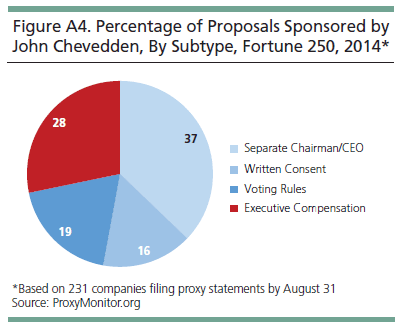 |
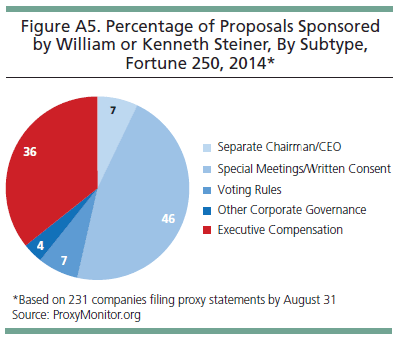 |
James McRitchie blogs about corporate governance at his website Corpgov.net and has recently emerged as a frequent sponsor of shareholder proposals. McRitchie (or his wife, Myra K. Young) sponsored no shareholder proposals at Fortune 250 companies in 2006 or 2007, one to three annually from 2008 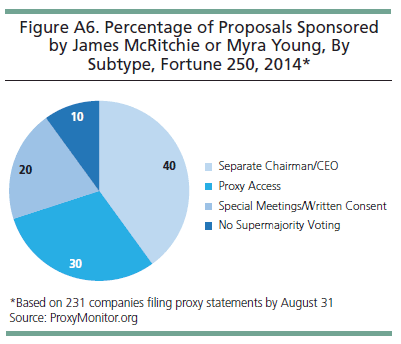 through 2010, five each in 2011 and 2012, nine in 2013, and 15 to date in 2014. McRitchie and Young’s proposals this year focused on allowing shareholders to call special meetings or act through written consent, to split the chairman and CEO roles, to eliminate supermajority voting rules from corporate bylaws, or to grant shareholders proxy access in nominating their own candidates for director (Figure A6).
through 2010, five each in 2011 and 2012, nine in 2013, and 15 to date in 2014. McRitchie and Young’s proposals this year focused on allowing shareholders to call special meetings or act through written consent, to split the chairman and CEO roles, to eliminate supermajority voting rules from corporate bylaws, or to grant shareholders proxy access in nominating their own candidates for director (Figure A6).
Social Investors
The number of shareholder proposals sponsored by investors with a social, religious, or policy orientation has remained relatively consistent in recent years: from 2011 through 2014, this class of investors sponsored between 60 and 64 proposals at Fortune 250 companies (Figure A7). There has been, however, a noticeable shift in which types of investors are most active—in comparison with earlier periods. From 2006 through 2010, a plurality of all proposals sponsored by social-, religious-, or policy-oriented investors were introduced by religious-affiliated groups—principally, Catholic orders of nuns and monks—but their activism fell sharply in 2011 and plummeted in 2012, before rebounding slightly in each of the last two years. This decline may have been due to a Vatican reprimand of U.S. nuns over perceived political radicalism.[95]
Social-investing funds marketed toward environmental, social, or “good governance” goals (“ESG”)[96] have filled much of the void left by Catholic orders in recent years in leading socially conscious shareholder-proposal activism. From 2006 through 2011, the number of shareholder proposals sponsored by social-investing funds was never greater than that sponsored by religious-oriented investors, but such funds have taken the lead in the last three years, sponsoring 35, 33, and 32 (to date) proposals, respectively, in 2012, 2013, and 2014 (Figure A8).
Coordination Among Shareholder Activists
Coordination of efforts by shareholder proponents is clear. Among Fortune 250 companies, in 2012, 15 percent of shareholder proposals had a co-filer, or listed an adviser or agent; in 2013, 17 percent; and in 2014, 17 percent. In many cases, these cosponsors are proponents of a similar class. For example, corporate gadflies will regularly designate another gadfly to act as their agent—such as one of the Steiners or McRitchie designating Chevedden. Multiple labor-affiliated pension funds, or multiple social-investing or religious pension funds, will regularly back a common proposal at a single company.
In some cases, common shareholder proposals will be sponsored at the same company among different-type investors. In 2014, 12 shareholder proposals were sponsored by co-filers of different types. Of these 12 proposals, five involved corporate political spending or lobbying. The New York State Common Retirement Fund was a co-proponent for five of these 12 proposals, AFSCME for two, and the Connecticut Retirement Plans for two. None of the 12 proposals with co-filers of different types in 2014 received majority support; a proposal seeking to separate the chairman and CEO positions at Honeywell, filed by John Chevedden and the Teamsters General Fund, came closest, receiving slightly more than 48 percent of the shareholder vote.
In recent years, the company AutoNation has called out John Chevedden, in particular, for his apparent coordination with the Machinists’ Union, which has been attempting to organize the company’s dealerships and which has consistently presented Chevedden’s proposals at its annual meetings. In its 2014 proxy statement, AutoNation noted:
Chevedden, a purported owner of no less than 100 shares, or approximately 0.0001%, of our common stock and a stockholder proponent that sends out stockholder proposals to a large number of companies every year, has been sending stockholder proposals to the Company since 2001, none of which have received a majority stockholder vote. Instead, each time one of his stockholder proposals has been presented at an Annual Meeting of AutoNation stockholders, our stockholders have soundly rejected it. Further, at each of the last eight Annual Meetings of AutoNation stockholders, rather than presenting the stockholder proposal himself, a representative of the International Association of Machinists and Aerospace Workers (the “Machinists”) presented the stockholder proposal from Mr. Chevedden on his behalf. It is not clear to us what the nature of Mr. Chevedden’s relationship is with the Machinists, or what his or the Machinists’ motivations are in making stockholder proposals, but we do know that the Machinists have been attempting to organize automotive dealership service technicians, including some of ours, for many years. While we do not ascribe improper motivations to Mr. Chevedden or the Machinists, we do not believe it is appropriate to make stockholder proposals based on personal or special interests—such as a desire to organize Company employees—or grievances against the Company that are not shared by stockholders as a whole.[97]
Although proving an “improper motivation” is difficult to impossible, any relationship between gadfly investors and labor-affiliated pension funds that may have motives beyond shareholder price maximization is worthy of continuing attention and study.
APPENDIX B:
Shareholder Advisory Votes on Executive Compensation
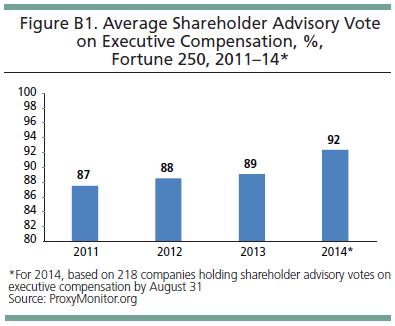 Beginning in 2011, publicly traded companies, under federal law, have had to hold annual, biannual, or triennial shareholder advisory votes on executive compensation. Shareholders at most companies have opted to hold such votes annually: there were 234 such votes at Fortune 250 companies in 2011, 222 in 2012, 223 in 2013, and 218 to date in 2014.
Beginning in 2011, publicly traded companies, under federal law, have had to hold annual, biannual, or triennial shareholder advisory votes on executive compensation. Shareholders at most companies have opted to hold such votes annually: there were 234 such votes at Fortune 250 companies in 2011, 222 in 2012, 223 in 2013, and 218 to date in 2014.
In general, shareholders have become more likely to support companies’ executive compensation over time. The average shareholder support for Fortune 250 companies’ plan has risen marginally each year, from 87 percent in 2011 to 92 percent this year (Figure B1). The number of companies failing to garner majority shareholder support for their plans was steady at 2 percent from 2011–13 (four or five companies each year) before dropping to below 1 percent in 2014 (two companies, Staples and TRW, received 46 and 44 percent shareholder support, respectively) (Figure B2). Moreover, the percentage of companies receiving the support of between 50 and 70 percent of shareholders has declined from 10 percent in 2011 to only 4 percent in 2014,[98] and the percentage of companies getting the support of 90 percent or more of shareholders has increased from 59 percent in 2011 to 79 percent so far this year (Figure B3).
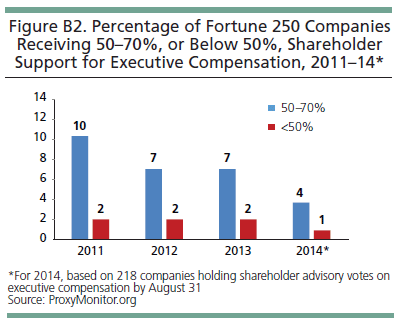 |
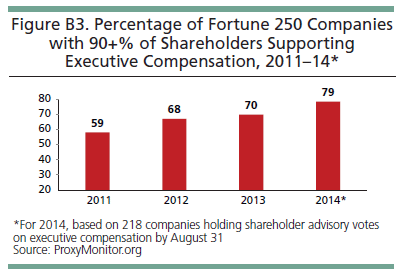 |
The reasons for increased shareholder support for companies’ executive-compensation packages are not entirely clear. Likely, as time has gone on, large companies have learned what major shareholders are looking for and have communicated their compensation approaches more effectively. Companies also may have modified their compensation approaches in line with shareholder sentiment—or the compensation methodologies of proxy advisors such as ISS.[99] (Whether such a shift would be salutary depends on one’s view of ISS’s approach, as well as the risks of adopting the approach as a one-size-fits-all model across all large publicly traded corporations.)
ENDNOTES
- Stockholders of publicly traded companies who have held shares valued at $2,000 or more for at least one year can introduce proposals for shareholders’ consideration at corporate annual meetings. See 17 C.F.R. § 240.14a-8 (2007) [hereinafter 14a-8]. The federal Securities and Exchange Commission determines the procedural appropriateness of a shareholder proposal for inclusion on a corporation’s proxy ballot, pursuant to the Securities Exchange Act of 1934, Pub. L. No. 73-291, Ch. 404, 48 Stat. 881 (1934) (codified at 15 U.S.C. §§ 78a–78oo (2006 & Supp. II 2009)), at §§ 78m, 78n & 78u; 15 U.S.C. §§ 80a-1 to 80a-64 (2000) (pursuant to Investment Company Act of 1940, Pub. L. No. 76-768, 54 Stat. 841(1940)); but the substantive rights governing such measures and how they can force boards to act remain largely a question of state corporate law; cf. Del. Code Ann., tit. 8, § 211(b) (2009) (noting that in addition to the election of directors, “any other proper business may be transacted at the annual meeting”).
- Under the Dodd-Frank Wall Street Reform and Consumer Protection Act of 2010, publicly traded companies must hold shareholder advisory votes on executive compensation annually, biennially, or triennially, at shareholders’ discretion. See Pub. L. No. 111-203, 124 Stat. 1376, §951 (2010) [hereinafter Dodd-Frank Act].
- See Proxy Monitor, Reports and Findings, http://proxymonitor.org/Forms/reports_findings.aspx (last visited Sept. 3, 2014).
- Those 16 companies are: Aon, Applied Materials, Ashland, Coca-Cola Enterprises, Devon Energy, Eaton, GameStop, Hillshire Brands, ITT, KBR, Motorola, Oshkosh, Principal Financial Group, Public Service Enterprise Group, Sempra Energy, and the Williams Companies.
- Those eight companies are: Constellation Energy, Coventry Health Care, Dell, H. J. Heinz, Medco, Smithfield Foods, Sunoco, and US Airways.
- See Heidi Welsh, Accuracy in Proxy Monitoring, HLS Forum on Corp. Gov. and Fin. Reg. (Sept. 16, 2013, 9:22 AM), https://blogs.law.harvard.edu/corpgov/2013/09/16/accuracy-in-proxy-monitoring-2 (critiquing Proxy Monitor data set).
- See Saumya Vaishampayan & Chris Dieterich, S&P 500 Closes Above 2000 for First Time: Markets Continue to Move Up in Absence of Any Pronounced Negative Factors, Wall St. J. (Aug. 26, 2014), http://online.wsj.com/articles/s-p-500-closes-above-2000-for-first-time-1409055874 (“The S&P 500 index notched its first-ever close above 2000 on Tuesday, a new milestone in the stock market’s march higher. Tuesday’s finish was the 30th record close this year for the index, which has gained 8.2% in 2014 through the end of trade on Tuesday”); see also Henny Sender, Stocks at Records Yet Recovery Is Elusive, Fin. Times (Aug. 29, 2014), http://www.ft.com/cms/s/0/5ac542b6-2ed7-11e4-a054-00144feabdc0.html#axzz3CpXEAWVq.
- Shareholder Activist Definition, Investopedia.com, http://www.investopedia.com/terms/s/shareholderactivist.asp (last visited Sept. 9, 2014) (“A person who attempts to use his or her rights as a shareholder of a publicly-traded corporation to bring about social change. Some of the issues most often addressed by shareholder activists are related to the environment, investments in politically sensitive parts of the world and workers’ rights (sweatshops). The term can also refer to investors who believe that a company’s management is doing a bad job and who attempt to gain control of the company and replace management for the good of the shareholders.”).
- See Mark Clothier & Alex Barinka, Navistar Turns Target After Poison Pill Adopted: Real M&A, Bloomberg (June 21, 2012), http://www.bloomberg.com/news/2012-06-21/navistar-turns-target-after-poison-pill-adopted-real-m-a.html; see also Paul Merrion, Gabelli Urges Navistar to Drop Poison Pill, Crain’s Chicago Bus. (Oct. 25, 2012), http://www.chicagobusiness.com/article/20121025/NEWS05/121029873/gabelli-urges-navistar-to-drop-poison-pill; see also Gene Marcial, What’s Up with Carl Icahn’s About-Face on Apple?, Forbes (Feb. 14, 2014),
http://www.forbes.com/sites/genemarcial/2014/02/14/whats-up-with-carl-icahns-about-face-on-apple.
- See, e.g., Lucian A. Bebchuk et al., The Long-Term Effects of Hedge Fund Activism, Columbia Bus. School Research Paper No. 13-66, July 9, 2013 (forthcoming, Colum. L. Rev.), http://papers.ssrn.com/sol3/papers.cfm?abstract_id=2291577.
- See Michael Chamberlain, Socially Responsible Investing: What You Need to Know, Forbes (Apr. 24, 2013), http://www.forbes.com/sites/feeonlyplanner/2013/04/24/socially-responsible-investing-what-you-need-to-know (“In general, socially responsible investors are looking to promote concepts and ideals that they feel strongly about.”).
- See Todd Gitlin & Heather Long, Combating Climate Change: Is Divesting from Fossil Fuel Companies a Good Idea?, The Guardian (Nov. 21, 2013), http://www.theguardian.com/commentisfree/2013/nov/21/fossil-fuel-company-divestment-climate-change; see also Jonathan Marks, Presbyterians Join the Anti-Israel Choir: Divesting from Companies Like Motorola Solutions to Show Solidarity with the Palestinians, Wall St. J. (Jun. 22, 2014), http://online.wsj.com/articles/jonathan-marks-presbyterians-join-the-anti-israel-choir-1403476490.
- See 14a-8, supra note 1.
- See, e.g., Business Roundtable & Chamber of Commerce of the U.S. v. SEC, 647 F.3d 1144, 1152 (D.C. Cir. 2011) (citing proposition that “investors with a special interest, such as unions and state and local governments whose interests in jobs may well be greater than their interest in share value, can be expected to pursue self-interested objectives rather than the goal of maximizing shareholder value”); see also OIG Department of Labor, “Proxy-Voting May Not Be Solely for the Economic Benefit of Retirement Plans,” report 09-11-001-12-121, introduction (Mar. 31, 2011), http://www.oig.dol.gov/public/reports/oa/2011/09-11-001-12-121.pdf (questioning whether labor pension funds are using “plan assets to support or pursue proxy proposals for personal, social, legislative, regulatory, or public policy agendas”).
- “Corporate gadflies,” as commonly used in Charles M. Yablon, Overcompensating: The Corporate Lawyer and Executive Pay, 92 Colum. L. Rev. 1867, 1895 (1992); and Jessica Holzer, Firms Try New Tack Against Gadflies, Wall St. J. (June 6, 2011), http://online.wsj.com/article/SB10001424052702304906004576367133865305262.html.
- See James R. Copland, Frequent Filers: Shareholder Activism by Corporate Gadflies (Manhattan Inst. for Pol’y Res., Finding 5, 2014), http://proxymonitor.org/Forms/2014Finding5.aspx#notes.
- See, e.g., Paul Rose, Common Agency and the Public Corporation, 63 Vand. L. Rev. 1355, 1356 (2010) (observing that “general trends have supported increased shareholder power and influence within public companies in recent years”).
- See Barry Burr, Institutional Investors Increase Ownership of U.S. Companies to All-Time High, Pensions & Investments (Sept. 5, 2008, 12:01 AM), http://www.pionline.com/article/20080905/ONLINE/809049969/institutional-investors-increase-ownership-of-us-companies-to-all-time-high#; see also Carolyn Kay Brancato & Stephan Rabimov, The 2008 Institutional Investment Report: Trends in Institutional Investor Assets and Equity Ownership of U.S. Corporations (The Conference Board 2008).
- See David F. Larcker et al., The Influence of Proxy Advisory Firm Voting Recommendations on Say-on-Pay Votes and Executive Compensation Decisions (The Conference Board 2012); see also Copland et al., Proxy Monitor 2012: A Report on Corporate Governance and Shareholder Activism, 22–23 (Manhattan Inst. for Pol’y Res., Fall 2012) [hereinafter Copland Fall 2012].
- See SEC Rel. No. 34-60215, http://www.sec.gov/rules/sro/nyse/2009/34-60215.pdf.
- Sarbanes-Oxley Act of 2002, Pub. L. No. 107-204, 116 Stat. 745 (2002).
- Dodd-Frank Act, supra note 2.
- Institutional Shareholder Services, About ISS, http://www.issgovernance.com/about/about-iss (last visited Sept. 9, 2014). A private organization that provides proxy voting and corporate-governance services to institutional investors, ISS evaluates proxy proposals and makes voting recommendations to its clients.
- Much of the material discussed in this part of the report was previously introduced in a series of “findings” published online in summer 2014. Proxy Monitor, Reports and Findings, 2014 Season, http://proxymonitor.org/Forms/reports_findings.aspx (last visited Sept. 3, 2014).
- See Dodd-Frank Act, supra note 2.
- See id.
- See Copland, Proxy Monitor 2013: Political Spending, Say on Pay, and Other Key Issues to Watch in the 2013 Proxy Season (Manhattan Inst. for Pol’y Res., Winter 2013), http://proxymonitor.org/Forms/pmr_05.aspx [hereinafter Copland Winter 2013]; see also Copland et al., Proxy Monitor 2013: Corporate Governance and Shareholder Activism (Manhattan Inst. for Pol’y Res., Fall 2013), available at http://proxymonitor.org/Forms/pmr_06.aspx [hereinafter Copland Fall 2013]; see also Copland, Proxy Monitor 2014: Companies Fight Back Against Chevedden; Unions and Social Investors Ramp Up Push on Corporate Political Spending (Manhattan Inst. for Pol’y Res., Winter 2014), http://proxymonitor.org/Forms/pmr_07.aspx [hereinafter Copland Winter 2014].
- See No-Action Letters, SEC, http://www.sec.gov/answers/noaction.htm (last visited Sept. 9, 2014).
- See, e.g., Andrew Ackerman, Corporations Take Swats at a Gadfly, Wall St. J. (Mar. 12, 2014), http://online.wsj.com/news/articles/SB10001424052702303546204579435512380561526?mod=vocus; Ning Chiu, Fifth Circuit Upholds Decision Against Chevedden as More Companies Seek 14a-8 Relief from Courts, Davis Polk & Wardwell LLP (Feb. 18, 2014), http://www.davispolk.com/briefing/corporategovernance/fifth-circuit-upholds-decision-against-chevedden-more-companies-seek; Waste Connections, Inc. v. Chevedden, No. 4:13-CV-00176 (S.D. Tex. June 3, 2013), aff’d, No. 13-20336, 2014 WL 554566 (5th Cir. Feb. 13, 2014), http://www.gpo.gov/fdsys/pkg/USCOURTS-ca5-13-20336/pdf/USCOURTS-ca5-13-20336-0.pdf.
- Society of Corporate Secretaries and Governance Professionals, http://www.ascs.org (last visited Sept. 9, 2014).
- Copland Winter 2013, supra note 27.
- U.S. Securities and Exchange Commission, Important Information About EDGAR, http://www.sec.gov/edgar/aboutedgar.htm (last visited Sept. 9, 2014).
- In determining shareholder support for shareholder proposals, the Manhattan Institute counts votes consistent with the practice dictated in a company’s bylaws, consistent with state law. Some companies measure shareholder support by dividing the number of votes for a proposal by the total number of shares present and voting, ignoring abstentions. Other companies measure shareholder support by dividing the number of favorable votes by the number of shares present and entitled to vote—thus including abstentions in the denominator of the tally. Neither practice necessarily skews shareholder votes in management’s favor: whereas the latter method makes it relatively more difficult for shareholder resolutions to obtain majority support, it also makes it more difficult for management to win shareholder backing for its own proposals, such as equity compensation plans.
Although shareholder-proposal activists prefer to exclude abstentions consistently in tabulating vote totals, without regard to corporate bylaws—which necessarily inflates apparent support for their proposals—such a methodology is inconsistent with federal law. The SEC’s Schedule 14A specifies that for “each matter which is to be submitted to a vote of security holders,” corporate proxy statements must “[d]isclose the method by which votes will be counted, including the treatment and effect of abstentions and broker non-votes under applicable state law as well as registrant charter and bylaw provisions”—clearly indicating that corporations can adopt varying counting methodologies in assessing shareholder votes and that state substantive law governs the parameters of vote calculation. Schedule 14A, Item 21. Voting Procedures, http://www.law.cornell.edu/cfr/text/17/240.14a-101 (last visited Sept. 9, 2014).
Under the state law of Delaware, in which most large public corporations are chartered, “the certificate of incorporation or bylaws of any corporation authorized to issue stock may specify the number of shares and/or the amount of other securities having voting power the holders of which shall be present or represented by proxy at any meeting in order to constitute a quorum for, and the votes that shall be necessary for, the transaction of any business.” Del. Gen. Corp. L. § 216. As a default rule, absent a bylaw specification, Delaware law specifies that “in all matters other than the election of directors,” companies should count “the affirmative vote of the majority of shares of such class or series or classes or series present in person or represented by proxy at the meeting,” id. at 216(4)—the precise inverse of shareholder-proposal activists’ preferred counting rule.
The SEC staff has adopted a rule for the very limited purpose of determining whether a proposal has met the “resubmission threshold” to qualify for inclusion on the next year’s corporate ballot—a permissive standard requiring merely a minimum 3 percent, 6 percent, or 10 percent vote, respectively, in successive years, see Amendments to Rules on Shareholder Proposals, Exchange Act Release No. 40,018; 63 Fed. Reg. 29,106, 29,108 (May 28, 1998) (codified at 17 C.F.R. pt. 240)—“[o]nly votes for and against a proposal are included in the calculation of the shareholder vote of that proposal,” ignoring abstentions. SEC Staff Legal Bulletin No. 14, F.4., July 13, 2001, http://www.sec.gov/interps/legal/cfslb14.htm (last visited Sept. 9, 2014). Because this is a staff rule not voted on by the commission; because it exists for a limited purpose (with multiple rationales, including reducing workload in processing 14a-8 no-action petitions and adopting a permissive standard for ballot inclusion); and because it contravenes clear and long-standing deference to substantive state law in the field of corporate governance, the notion that this limited SEC staff vote-counting rule should dictate counting methodology, irrespective of state law and governing corporate bylaws, is untenable.
- For example, according to the Harvard Shareholder Rights Project, which has advocated the proposal to declassify staggered boards, two-thirds of the S&P 500 companies that had classified boards as of 2012 have now changed their practice. See 121 Companies Agreeing to Move Toward Annual Director Elections, http://srp.law.harvard.edu/companies-entering-into-agreements.shtml (last visited Sept. 9, 2014).
- For example, among companies facing board-declassification proposals introduced through efforts of the Harvard Shareholder Rights Project, 56 percent agreed to declassify their boards in 2012, 68 percent in 2013, and 76 percent in 2014. See id.
- The federal Securities and Exchange Commission determines the procedural appropriateness of a shareholder proposal for inclusion on a corporation’s proxy ballot, pursuant to the Securities Exchange Act of 1934, Pub. L. No. 73-291, Ch. 404, 48 Stat. 881 (1934) (codified at 15 U.S.C. §§ 78a–78oo [2006 & Supp. II 2009]), at §§ 78m, 78n & 78u; 15 U.S.C. §§ 80a-1 to 80a-64 (2000) (pursuant to Investment Company Act of 1940, Pub. L. No. 76-768, 54 Stat. 841 (1940)). But the substantive rights governing such measures and how they can force boards to act remain largely a question of state corporate law. Cf. Del. Code Ann., tit. 8, § 211(b) (2009) (noting that in addition to the election of directors, “any other proper business may be transacted at the annual meeting”).
- See Med. Comm. for Human Rights v. SEC, 432 F.2d 659, 682 (D.C. Cir. 1970) (remanding to the SEC for reconsideration a no-action letter that would have permitted Dow Chemical to exclude from its proxy statement a shareholder proposal involving its sale of napalm), aff’d 404 U.S. 403 (1972) (affirmed for mootness, after Dow had included the resolution on its proxy).
- Business Roundtable, 647 F.3d at 1148.
- Although two of eight proposals seeking shareholder power to call special meetings received majority support in 2014, the same general trends apply for that proposal class. After a single special-meetings proposal was introduced in 2006 at JPMorgan Chase by the SEIU Master Trust and received 64 percent of the vote, various individual investors, including John Chevedden and William and Kenneth Steiner, began to introduce such proposals in significant numbers. Seven of 11 such proposals received majority shareholder support in 2007, eight of 20 in 2008, and 18 of 40 in 2009. Support fell in 2010, when only seven of 35 special-meetings proposals won the backing of shareholder majorities, and then fell markedly thereafter: one of 22 in 2011, one of nine in 2012, one of seven in 2013, and two of eight this year.
- 558 U.S. 310 (2010).
- See Center for Political Accountability, About the CPA, http://www.politicalaccountability.net/index.php?ht=d/sp/i/870/pid/870/pid/190 (last visited Sept. 9, 2014); see also Center for Political Accountability, Political Disclosure and Oversight Resolution 2013, http://www.politicalaccountability.net/index.php?ht=d/sp/i/867/pid/867 (last visited Sept. 9, 2014).
- A 2006 spending-disclosure proposal introduced at Amgen did receive majority-shareholder support (67 percent) after the proposal was supported by management.
- See Business Roundtable, 647 F.3d at 1144.
- Copland Winter 2013, supra note 27.
- See Copland, Special Report: Labor-Affiliated Shareholder Activism (Manhattan Inst. for Pol’y Res., Finding 3, 2014), http://proxymonitor.org/Forms/2014Finding3.aspx.
- See Chamberlain, supra note 11 (defining “socially responsible investing”).
- Although pension plans are generally bound as fiduciaries under the Employee Retirement Income Security Act (ERISA) to maximize share value in their pension management, 29 C.F.R. § 2509.08-2(1) (2008), those affiliated with religious organizations are exempt from this requirement, 29 U.S.C. § 1003(b).
- Copland Fall 2013, supra note 27, at 8.
- The other four companies that gave more money to Democrats and were targeted by labor-affiliated pension funds seem to have been selected for other reasons. The labor-affiliated Amalgamated Bank, the International Brotherhood of Electrical Workers, and the AFL-CIO, respectively, introduced proposals at Avon, Comcast, and DuPont addressing the accelerated vesting of change-in-control equity awards for management—commonly called “golden parachutes” by critics. DuPont also faced a proposal by its company-affiliated pension plan seeking a report on plant closures. Finally, the Massachusetts Laborers Pension Fund and the Firefighters’ Pension of Kansas City, Missouri, each introduced proposals at Google, respectively seeking to separate the company’s chairman and CEO positions and to require directors to win majority shareholder support for election.
- Trillium Asset Management is “the oldest independent investment advisor devoted exclusively to sustainable and responsible investing, and the fund actively “leverages the power of stock ownership to promote social and environmental change,” Trillium Asset Management, About Us, http://www.trilliuminvest.com/socially-responsible-investment-company (last visited Sept. 9, 2014).
- The Nathan Cummings Foundation is a charitable foundation “committed to democratic values and social justice” that “seek[s] to build a socially and economically just society that values nature and protects the ecological balance for future generations; promotes humane health care; and fosters arts and culture that enriches communities.” Nathan Cummings Foundation, About the Foundation, http://www.nathancummings.org/about-the-foundation (last visited Sept. 9, 2014).
- Three shareholder proposals related to social or policy concerns that were listed on Fortune 250 companies’ proxy ballots from 2006 through 2014 did receive majority shareholder support after the board recommended a vote “For” the proposal: a 2006 proposal at Amgen seeking additional disclosures of corporate political spending, a 2007 proposal at Newmont requesting that a board committee produce a report on the company’s local community policies and practices, and a 2014 proposal at Kraft seeking a laudatory resolution on animal welfare. In addition, at one company in the Proxy Monitor data base, KBR, a 2011 proposal by the New York City pension funds asking the company to amend its employment guidelines explicitly to prohibit discrimination based on sexual orientation received 55 percent of the shareholder vote over board opposition; KBR dropped to number 334 on the 2013 Fortune 500 list and is thus not in the Fortune 250 for purposes of this report. See Fortune 500 2013, KBR, Inc., available at http://fortune.com/fortune500/2013/kbr-inc-334 (last visited Sept. 9, 2014).
- U.S. Securities and Exchange Commission, Proxy Voting: Proxy Voting Responsibilities of Investment Advisers and Availability of Exemptions from the Proxy Rules for Proxy Advisory Firms, Staff Legal Bulletin No. 20 (IM/CF) (June 30, 2014), http://www.sec.gov/interps/legal/cfslb20.htm; see also Daniel M. Gallagher, Outsized Power & Influence: The Role of Proxy Advisers, Washington Legal Foundation Critical Legal Issues Working Paper Series, No. 187, at 11–15 (Aug. 2014) (discussing the SEC’s policy response, through Bulletin No. 20, to the increasing significance of proxy advisory firms).
- Video recording: Proxy Advisory Services Roundtable, held by the U.S. Securities and Exchange Commission (Dec. 5, 2013), http://www.sec.gov/news/otherwebcasts/2013/proxy-advisory-services-roundtable-120513.shtml.
- Examining the Market Power and Impact of Proxy Advisory Firms: Hearing Before the Subcomm. on Capital Markets and Government Sponsored Enterprises of the H. Comm. on Fin. Serv., 113th Cong. (2013).
- See Letter from U.S. Dep’t of Labor to Helmuth Fandl, Chairman of Retirement Board, Avon Products, Inc. (Feb. 23, 1988); see also 73 Fed. Reg. 61731 (Oct. 17, 2008).
- See 68 Fed. Reg. 6585 (Feb. 7, 2003) (“The duty of care requires an adviser with proxy voting authority to monitor corporate events and to vote the proxies. To satisfy its duty of loyalty, the adviser must cast the proxy votes in a manner consistent with the best interest of its client and must not subrogate client interests to its own” (internal citations omitted)).
- See SEC Rel. No. 34-60215, http://www.sec.gov/rules/sro/nyse/2009/34-60215.pdf.
- See Dodd-Frank Act, supra note 2.
- See Investment Company Institute, Trends in Proxy Voting by Registered Investment Companies, 2007–09, 16 Research Perspective 4 (Nov. 2010), http://www.ici.org/pdf/per16-01.pdf.
- See Institutional Shareholder Services, supra note 23.
- See Robyn Bew & Richard Fields, Voting Decisions at US Mutual Funds: How Investors Really Use Proxy Advisers 6 (Tapestry Networks, Inc. & Investment Research Center Institute, June 2012), http://www.tapestrynetworks.com/issues/corporate-governance/upload/Voting-Decisions-at-US-Mutual-Funds-June-2012.pdf.
- See Tamara Bellinfanti , The Proxy Advisory and Corporate Governance Industry: The Case for Increased Oversight and Control, 14 Stan. J.L. Bus. & Fin. 14 (Spring 2009).
- See Press Release, Vestal Capital Partners Completes Acquisition of Institutional Shareholder Services, http://www.issgovernance.com/vestar-capital-partners-completes-acquisition-of-institutional-shareholder-services (last visited Sept. 3, 2014).
- Aaron Lucchetti, MSCI Seizes RiskMetrics in Union of Niche Firms, Wall St. J. (Mar. 2, 2010), http://online.wsj.com/articles/SB10001424052748704754604575095100547835756.
- See Bew & Fields, supra note62, at 6.
- See Institutional Shareholder Services, supra note 23.
- Copland Fall 2012, supra note 19, at 22–23.
- Leo E. Strine, Jr., The Delaware Way: How We Do Corporate Law and Some of the New Challenges We (and Europe) Face, 30 Del. J. Corp. L. 688 (2005).
- See Institutional Shareholder Services, supra note 23.
- See MSCI 2013 Annual Report 70, “Summary of Operations,” “Governance,” available at http://files.shareholder.com/downloads/MSCI/3458217323x0x739303/DAB046E7-737E-43C7-9114-040465AD560E/2013_Annual_Report.pdf [hereinafter MSCI 2013].
- Compare id. at 10 with MSCI 2011 Annual Report 9, available at http://files.shareholder.com/downloads/MSCI/2008427917x0x554571/96AD1F8D-CC19-4BFD-9E47-6EFD2079886C/264713_007_MSCI_BMK_AR.pdf.
- Cf. Bryan Caplan, The Myth of the Rational Voter (2007). Institutional investors compete aggressively for investor dollars, and they gain competitive advantages largely through higher returns and lower fees. Investing in proxy-voting information raises institutional investors’ costs while giving no competitive advantage in increasing investment returns, at least for smaller, diversified investors who have low ownership shares—and whose individual votes on proxy ballot items are therefore unlikely to be dispositive. For a fuller discussion of these dynamics, see James K. Glassman & Hester Peirce, How Proxy Advisory Services Became So Powerful (Mercatus Ctr., June 18, 2014), http://mercatus.org/publication/how-proxy-advisory-services-became-so-powerful.
- Just over $79 million of ISS’s revenues come from its advisory services business, as opposed to corporate contracts. See MSCI 2013, supra note 70, at 9–10.
- See Copland Fall 2012, supra note 19, at 23.
- See ISS, 2014 U.S. Proxy Voting Summary Guidelines 7–28 (Mar. 12, 2014), http://www.issgovernance.com/file/2014_Policies/ISSUSSummaryGuidelines2014March12.pdf.
- Among Fortune 200 companies from 2006 through 2012, ISS supported these classes of proposals at least 94 percent of the time, save separating the chairman and CEO roles, which it supported 68 percent of the time. See Copland Fall 2012, supra note 19, at 22–23.
- MSCI, Corporate Governance Policies, http://ir.msci.com/documentdisplay.cfm?DocumentID=2979 (last visited Sept. 9, 2014).
- See Copland Fall 2012, supra note 19, at 23.
- See ISS, supra note 76, at 56–66.
- See Copland Fall 2012, supra note 19, at 22–23.
- See Alex Baumgart, SEC Drops Political Spending Disclosure from 2014 Agenda, OpenSecrets.org, Dec. 3, 2013, http://www.opensecrets.org/news/2013/12/sec-drops-political-spending-disclo.html; see also The Committee on Disclosure of Corporate Political Spending, Petition for Rulemaking, Aug. 3, 2011, http://www.sec.gov/rules/petitions/2011/petn4-637.pdf; James R. Copland, Against an SEC-Mandated Rule on Political Spending Disclosure: A Reply to Bebchuk and Jackson, 3 Harv. Bus. L. Rev. 381, 408 (2013) (“The actual shareholder votes held in recent years on the numerous shareholder proposals introduced on corporate political spending, including those calling for increased disclosure such as that advocated by professors Bebchuk and Jackson, show[] clearly that a majority of shareholders believe that increased disclosure of corporate political spending is not in their interests”) (emphasis in original), available at http://www.hblr.org/wp-content/uploads/2013/10/HLB209_crop.pdf.
- SEC, Petition for Rulemaking Regarding Resubmission of Shareholder Proposals Failing to Elicit Meaningful Shareholder Support (2014), http://www.sec.gov/rules/petitions/2014/petn4-675.pdf. The SEC currently requires companies to permit shareholders to resubmit substantially similar shareholder proposals on proxy ballots if such proposals have received a minimum 3 percent, 6 percent, or 10 percent vote, excluding abstentions, in the first, second, and third years of such proposals’ introduction; see Amendments to Rules on Shareholder Proposals, Exchange Act Release No. 40,018; 63 Fed. Reg. 29,106, 29,108 (May 28, 1998) (codified at 17 C.F.R. pt. 240), http://www.sec.gov/rules/final/34-40018.htm#foot9 (“If the proposal deals with substantially the same subject matter as another proposal or proposals that has or have been previously included in the company’s proxy materials within the preceding 5 calendar years, a company may exclude it from its proxy materials for any meeting held within 3 calendar years of the last time it was included if the proposal received: (i) Less than 3% of the vote if proposed once within the preceding 5 calendar years; (ii) Less than 6% of the vote on its last submission to shareholders if proposed twice previously within the preceding 5 calendar years; or (iii) Less than 10% of the vote on its last submission to shareholders if proposed three times or more previously within the preceding 5 calendar years”).
- U.S. Securities and Exchange Commission, Proxy Voting: Proxy Voting Responsibilities of Investment Advisers and Availability of Exemptions from the Proxy Rules for Proxy Advisory Firms, Staff Legal Bulletin No. 20 (IM/CF) (June 30, 2014), http://www.sec.gov/interps/legal/cfslb20.htm.
- See generally Copland, supra note 82.
- Cf. Med. Comm. for Human Rights, 432 F.2d 659. The SEC previously had a rule that a corporation could exclude a shareholder proposal from the proxy ballot “[i]f it clearly appears that the proposal is submitted by the security holder . . . primarily for the purpose of promoting general economic, political, racial, religious, social or similar causes.” Rule 14a-8(c)(2), 17 C.F.R. § 240.14a-8(c) (1970). In its 1970 Medical Committee for Human Rights opinion, the D.C. Circuit sharply questioned this rule as applied in an April 2, 1969, no-action letter to Dow Chemical, stating that “no objection [would] be raised if the Company omits the proposals from its proxy statements for the forthcoming meeting of shareholders,” regarding a shareholder proposal that the company cease manufacturing napalm. 432 F.2d at 663. The opinion stated:
No reason has been advanced in the present proceedings which leads to the conclusion that management may properly place obstacles in the path of shareholders who wish to present to their co-owners, in accord with applicable state law, the question of whether they wish to have their assets used in a manner which they believe to be more socially responsible but possibly less profitable than that which is dictated by present company policy. Thus, even accepting Dow’s characterization of the purpose and intent of the Medical Committee’s proposal, there is a strong argument that permitting the company to exclude it would contravene the purpose of section 14(a).... We think that there is a clear and compelling distinction between management’s legitimate need for freedom to apply its expertise in matters of day-to-day business judgment, and management’s patently illegitimate claim of power to treat modern corporations with their vast resources as personal satrapies implementing personal political or moral predilections. It could scarcely be argued that management is more qualified or more entitled to make these kinds of decisions than the shareholders who are the true beneficial owners of the corporation; and it seems equally implausible that an application of the proxy rules which permitted such a result could be harmonized with the philosophy of corporate democracy which Congress embodied in section 14(a) of the Securities Exchange Act of 1934.
Id. at 681. Technically, the court did not overturn the SEC’s rule but rather remanded to the commission for reconsideration so that “the basis for (its) decision (may) appear clearly on the record, not in conclusory terms but in sufficient detail to permit prompt and effective review.” Id. at 682. Thus, the commission could adopt a similar rule to its earlier Rule 14a-8(c)(2), providing sufficient rationale for the rule, to exclude many social- or policy-oriented proposals—though it may be hesitant to do so in light of the strong language of the D.C. Circuit’s 44-year-old opinion, notwithstanding subsequent evolution away from some of the premises underlying the court’s analysis. Similarly, because substantive state law governs shareholder rights and responsibilities in this area, Delaware or other states could adopt mandatory or default rules for certain corporate forms that would curtail the practice of permitting social- or policy-oriented shareholder proposals to be introduced.
- The NTSLRS includes the Police and Fire Retirement System (PFRS) and the Employees’ Retirement System (ERS); but note that teacher pensions are separately managed by the New York State Teachers’ Retirement System (NYSTRS).
- See Office of the State Comptroller, Fiduciary Responsibilities of the Comptroller, http://www.osc.state.ny.us/pension/fiduciary.htm (last visited Sept. 9, 2014).
- See Danny Hakim, Thomas P. DiNapoli, a Nice Guy Who Wound Up Finishing First, N.Y. Times (Feb. 8, 2007), http://www.nytimes.com/2007/02/08/nyregion/08man.html?_r=1&; see also Michael Cooper, Hevesi Resigns, Pleading Guilty to Fraud Count, N.Y. Times
(Dec. 22, 2006), http://www.nytimes.com/2006/12/22/nyregion/22cnd-hevesi.html?_r=0.
- See Aaron Elstein, Liu Cuts to the Chase, Crain’s (Apr. 14, 2013), http://www.crainsnewyork.com/article/20130414/POLITICS/304149974.
- For example, the board of the $46 billion Teachers’ Retirement System (TRS) includes the comptroller, two mayoral delegates, a delegate from the education chancellor, and three teacher delegates. See TRSNYC, Our Retirement Board, https://www.trsnyc.org/trsweb/aboutUs/ourRetirementBoard.html (last visited Sept. 9, 2014). The board of the $43 billion New York City Employees’ Retirement System (NYCERS) includes the comptroller, the public advocate, a mayoral representative, each of the five New York City borough presidents, and three union delegates. See NYCERS, Board of Trustees, http://www.nycers.org/(S(azvv04mpy1qd2j5515dyny55))/about/Board.aspx (last visited Sept. 9, 2014).
- See Ross Kerber, This Man Has Quietly Transformed Corporate America, Bus. Insider (Oct. 24, 2013), http://www.businessinsider.com/this-man-has-quietly-transformed-corporate-america-2013-10.
- See id.
- See id; see also Nathaniel Popper, Step by Step, Activist Investors Gaining Clout, Salt Lake City Trib., Sept. 4, 2010.
- Wyatt Andrews, Vatican Reprimands U.S. Nuns over “Radical Feminist Themes,” CBS News (Apr. 12, 2012), http://www.cbsnews.com/news/vatican-reprimands-us-nuns-over-radical-feminist-themes.
- See Chamberlain, supra note 11 (“Investment in companies and governments that the investor believes best hold to values of importance to the investor. These include the environment, consumer protection, religious beliefs, employees’ rights as well as human rights, among others. These areas of concern can be summarized as ‘Environmental, Social and Governance’ and is referred to as ESG investing. In addition, SRI includes shareholder advocacy and community investing.”).
- AutoNation, Inc., Proxy Statement Pursuant to Section 14(a) of the Securities Exchange Act of 1934, proposal no. 5 (Mar. 24, 2014), https://www.sec.gov/Archives/edgar/data/350698/000035069814000041/a2014proxystatement.htm.
- For companies, obtaining the support of 70 percent of shareholders in a shareholder advisory vote on executive compensation is significant, given the importance that ISS places on that threshold. If a company falls below 70 percent support, then ISS expects the company to “respon[d]” to investors’ concerns and, if insufficiently satisfied, the proxy advisor will punish the company in future say-on-pay vote recommendations as well as, potentially, by withholding support for the company’s nominees for director. See ISS, supra note 76, at 12.
- See generally ISS, supra note 76, at 38–55.